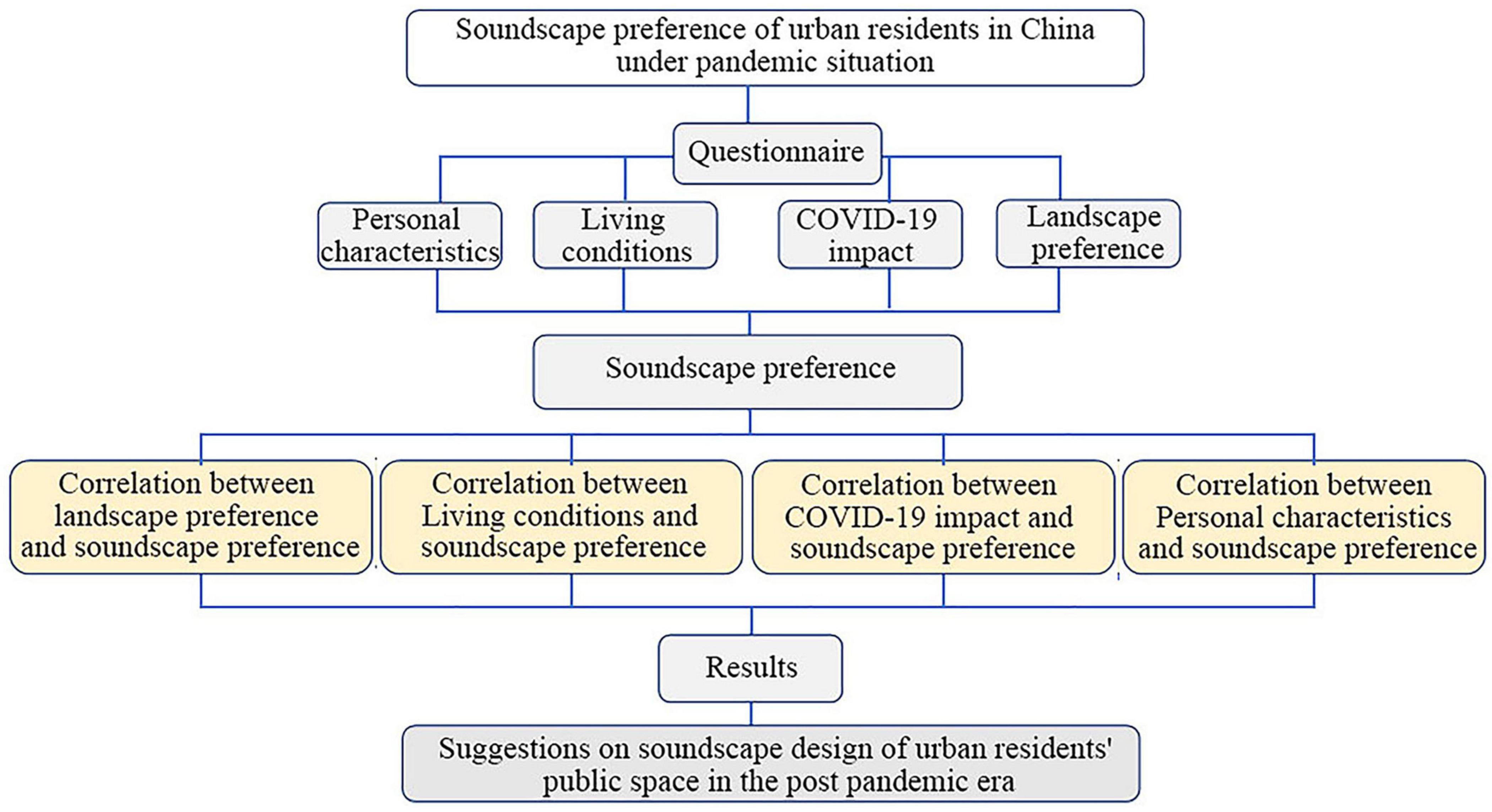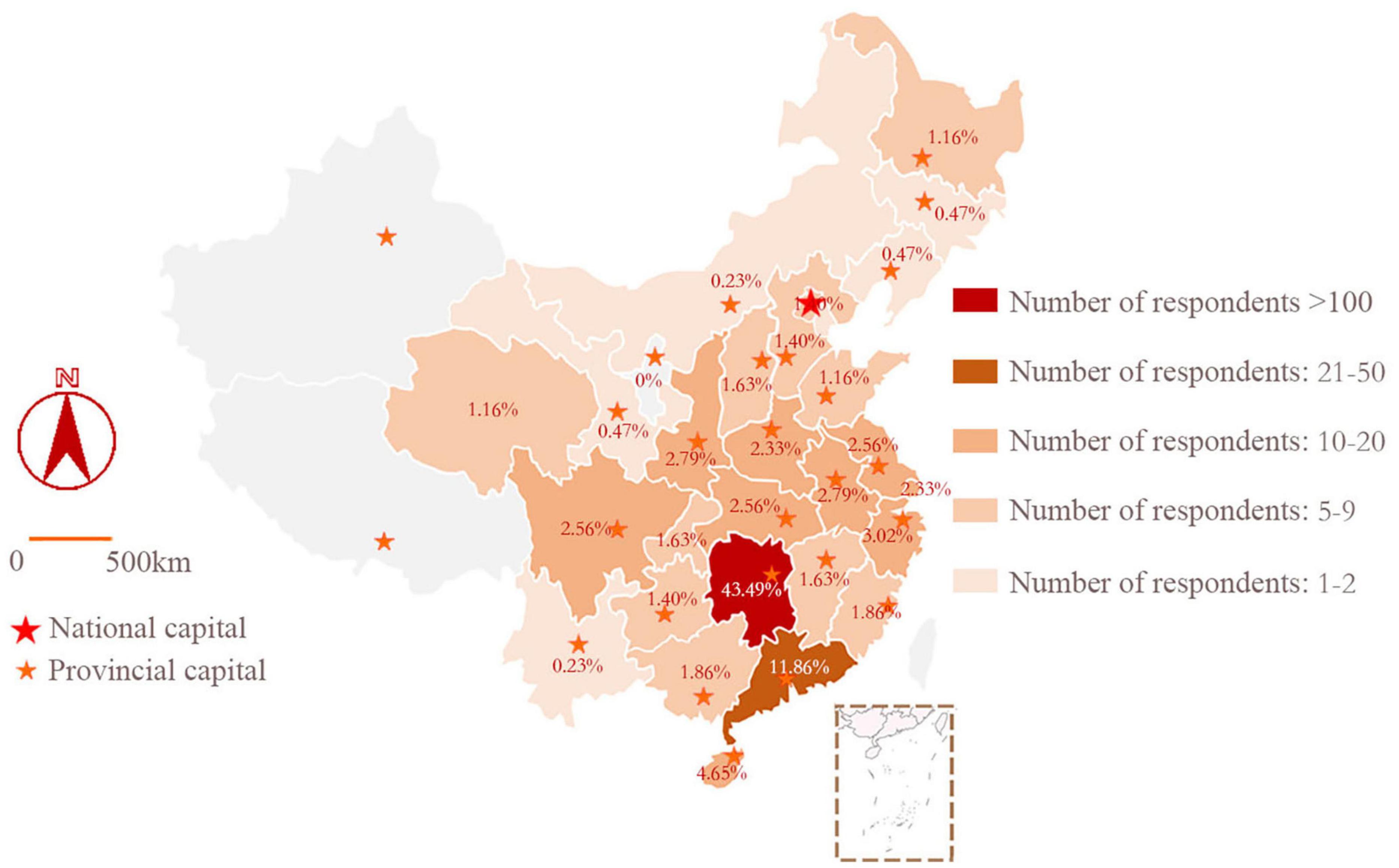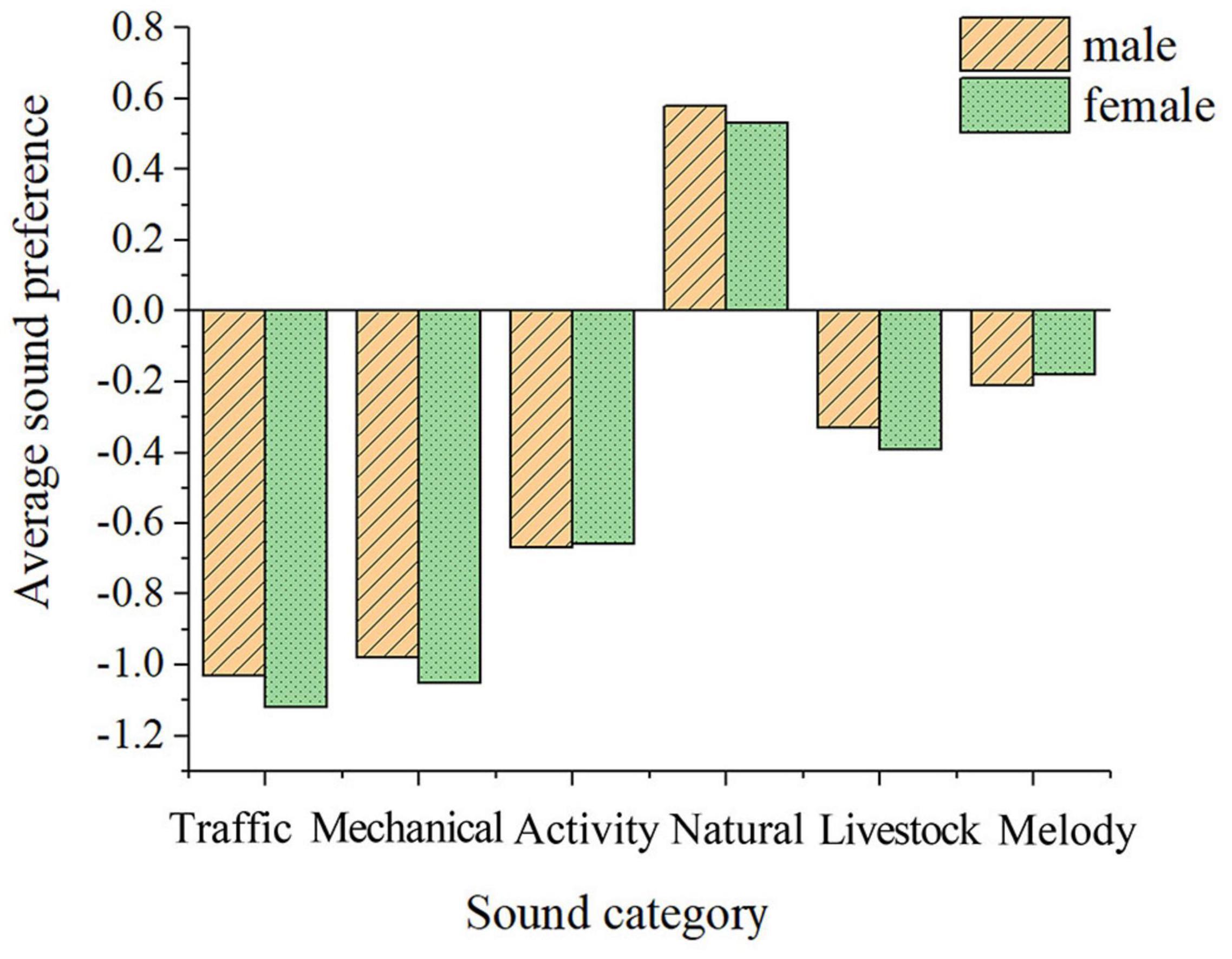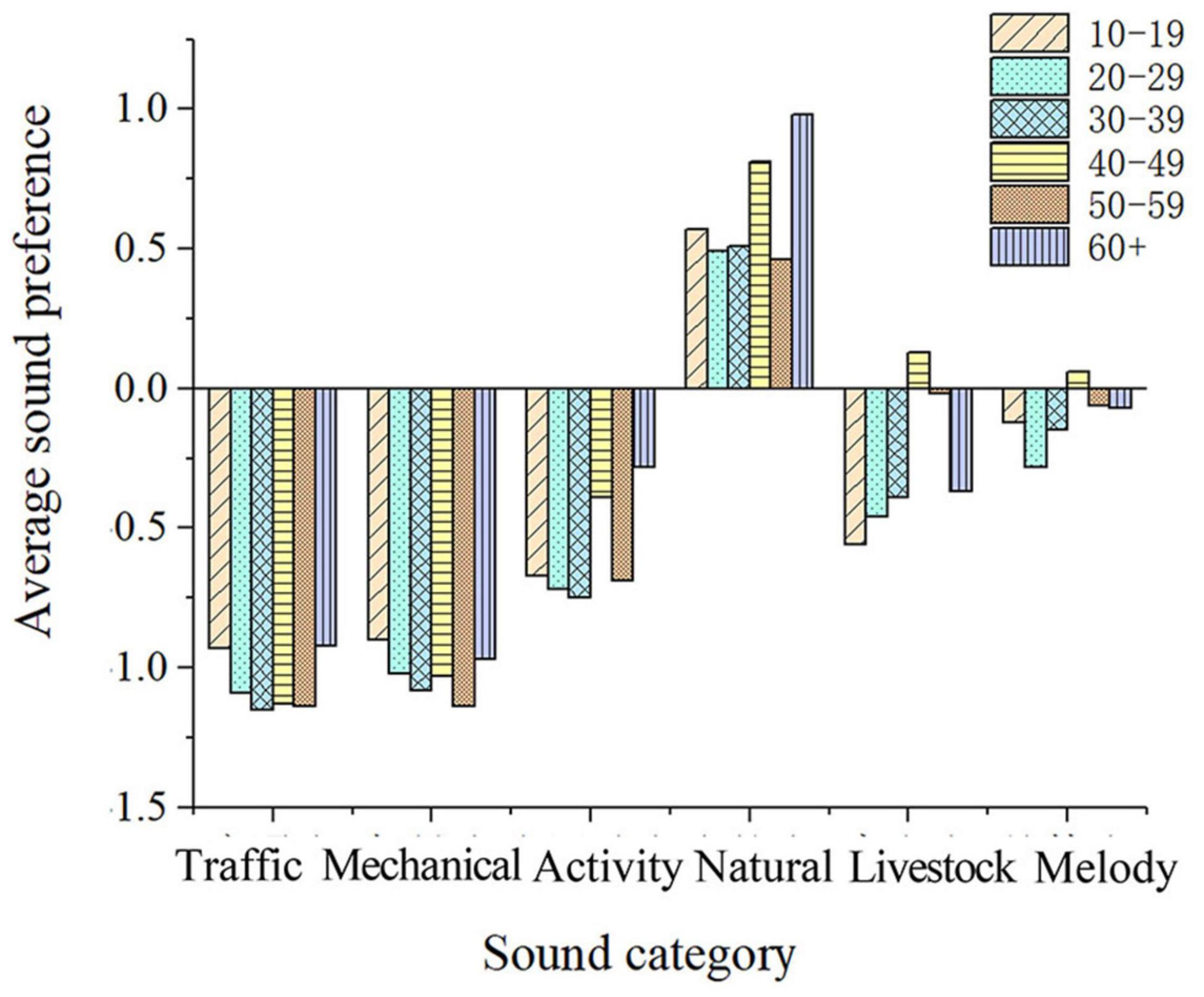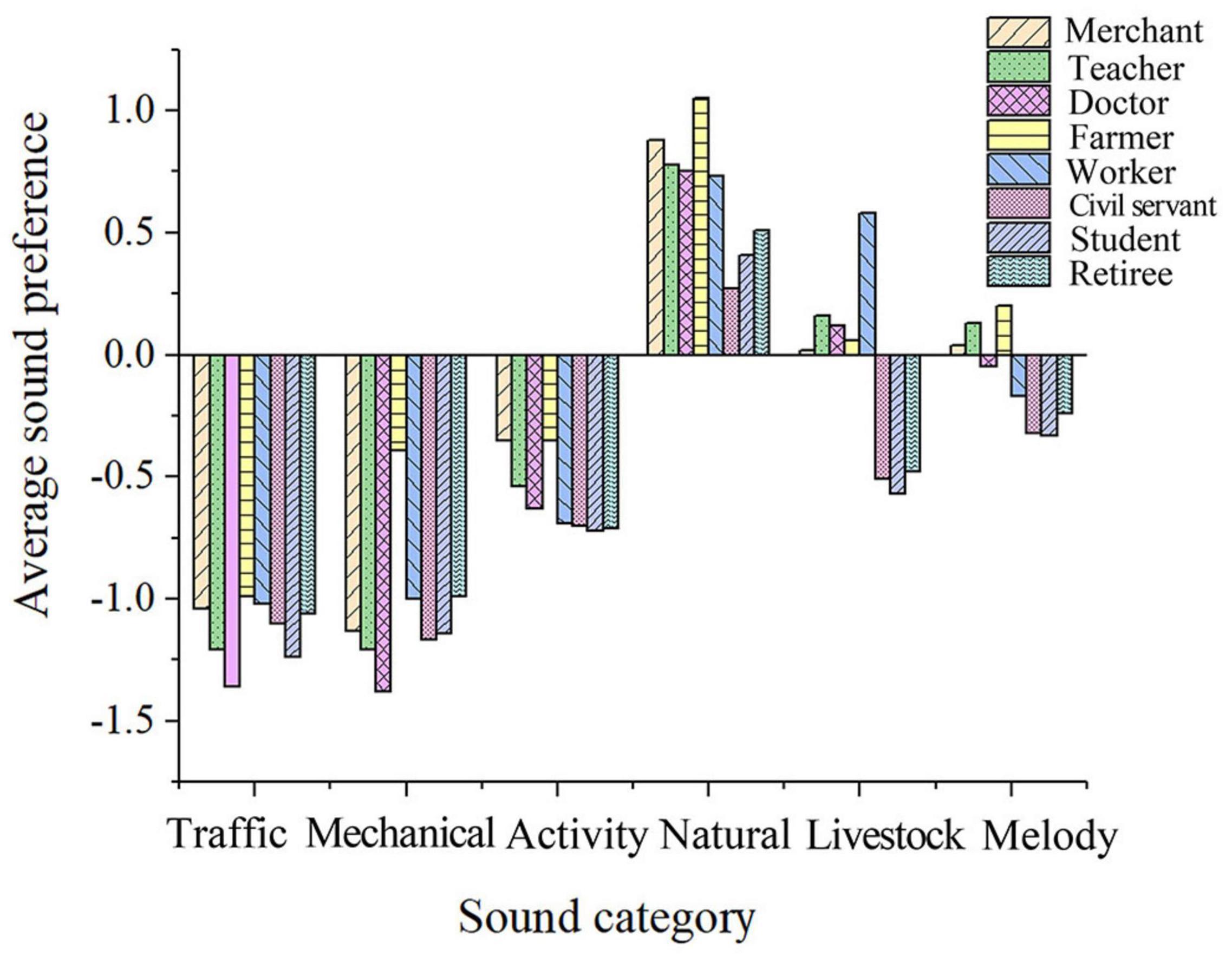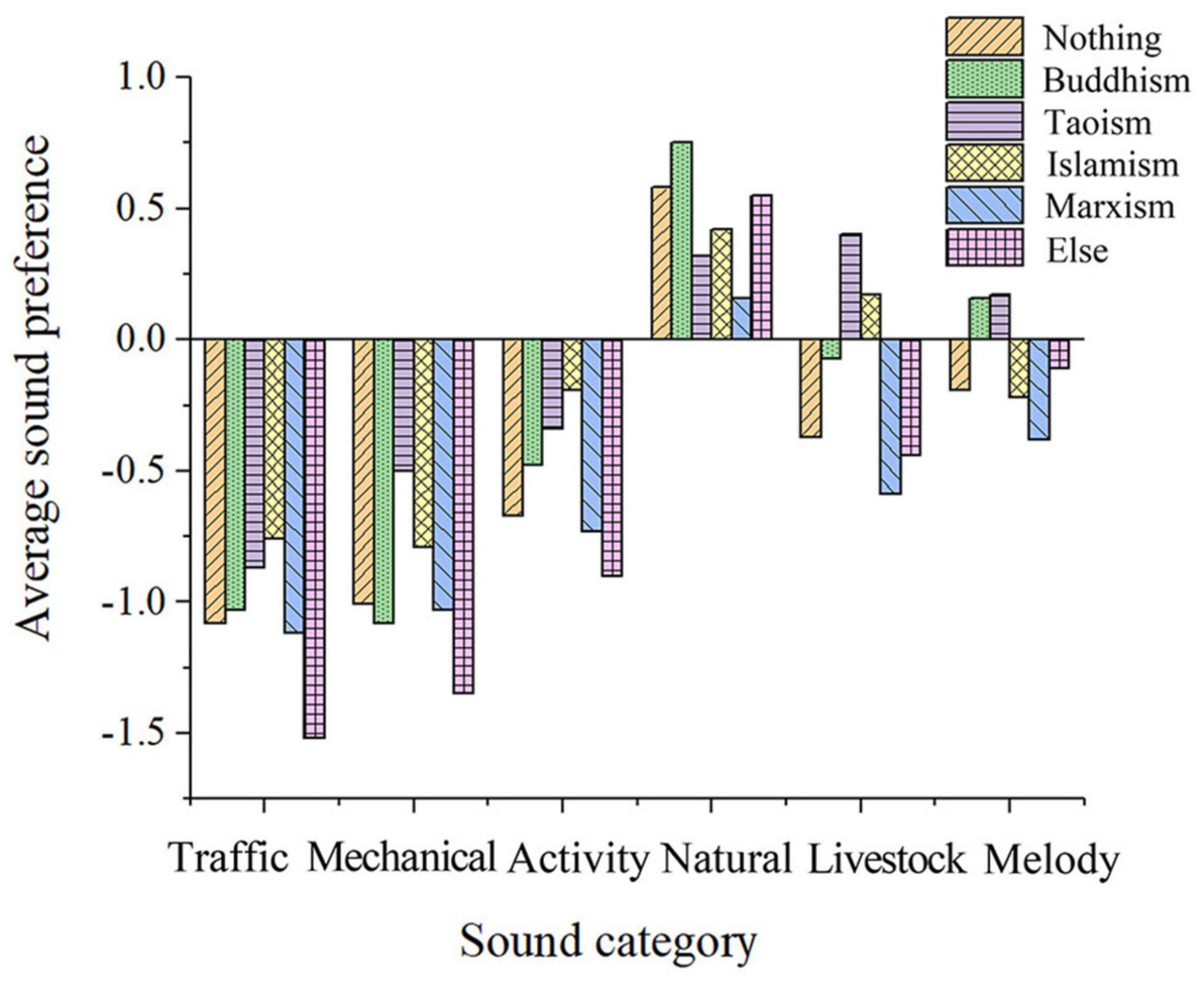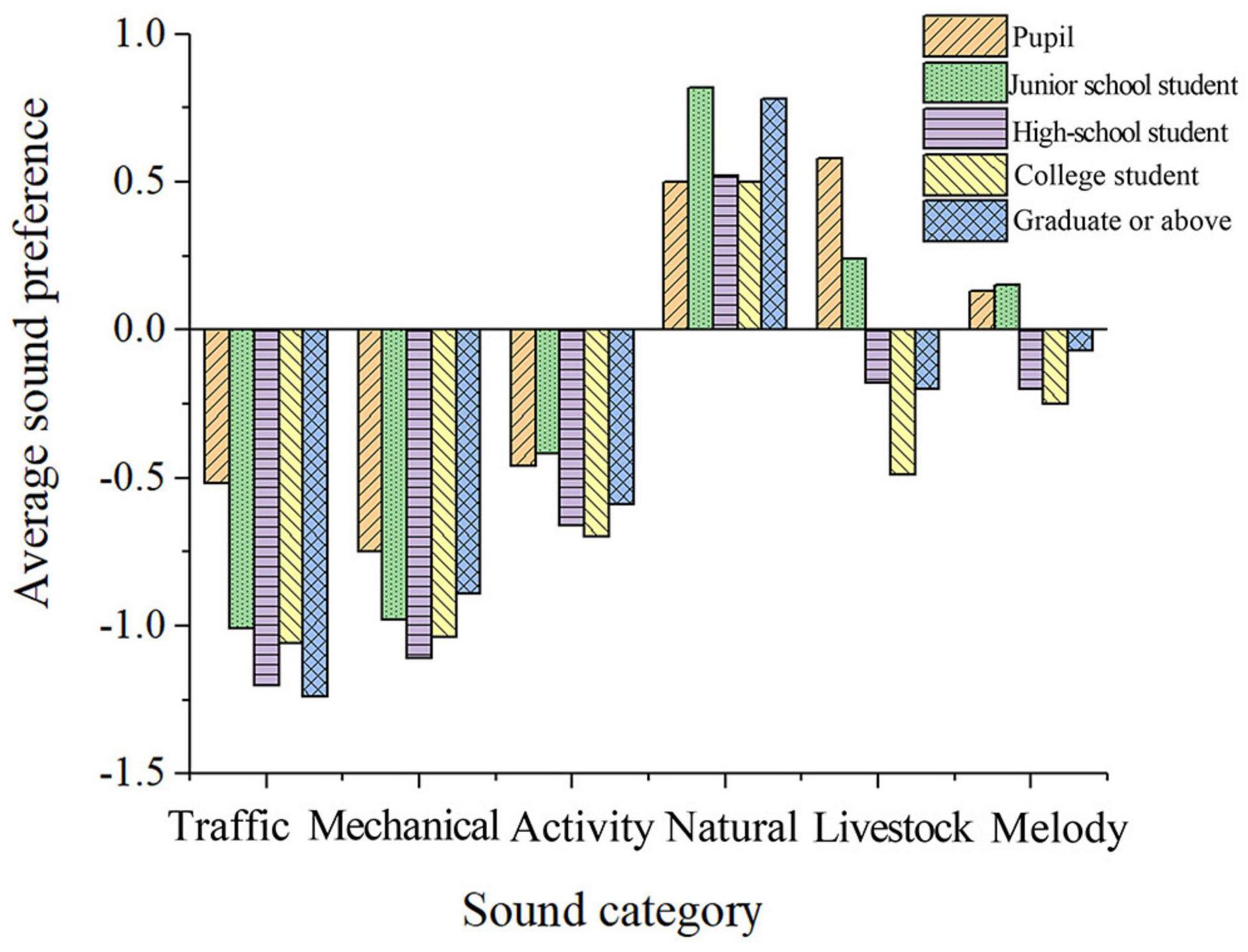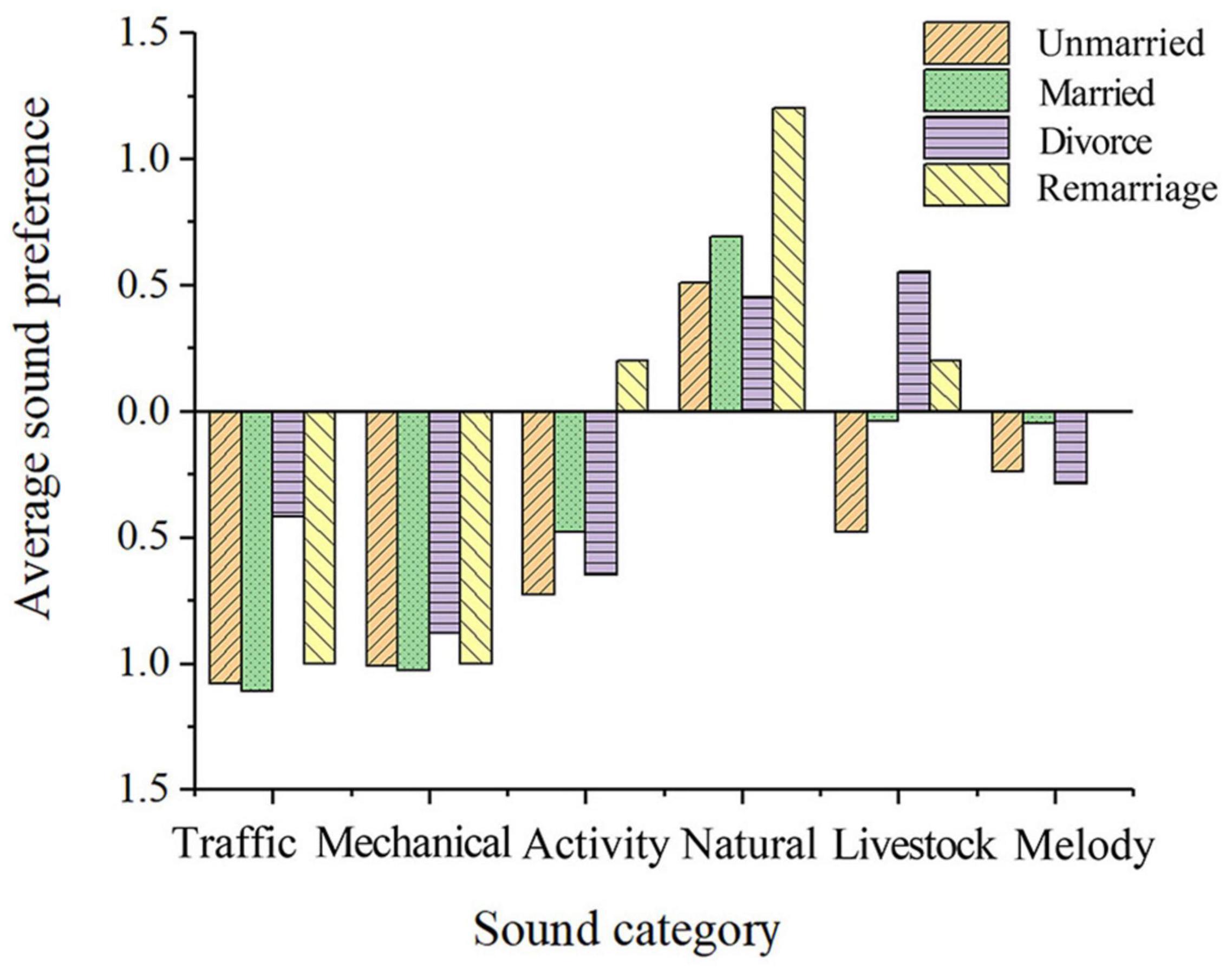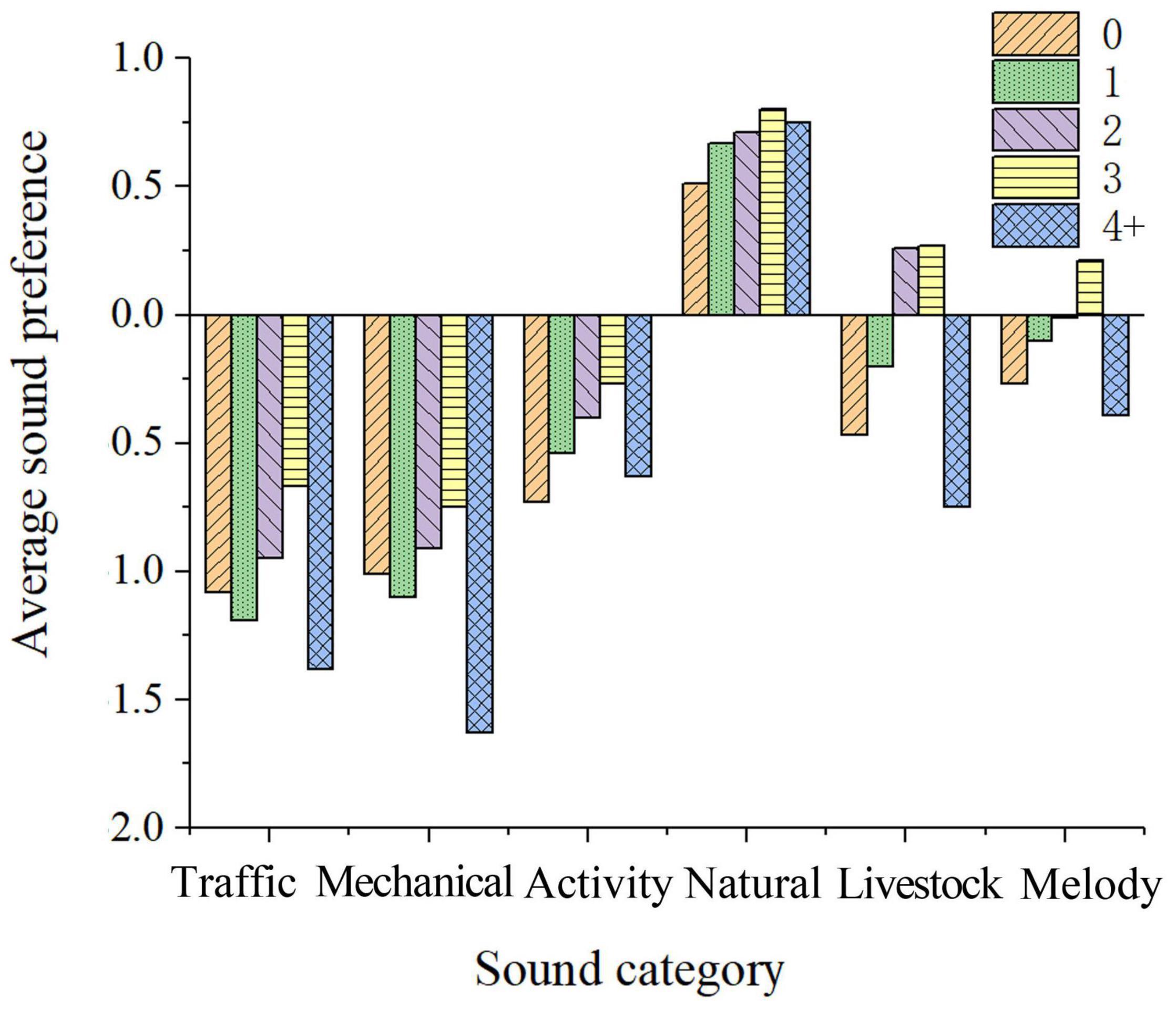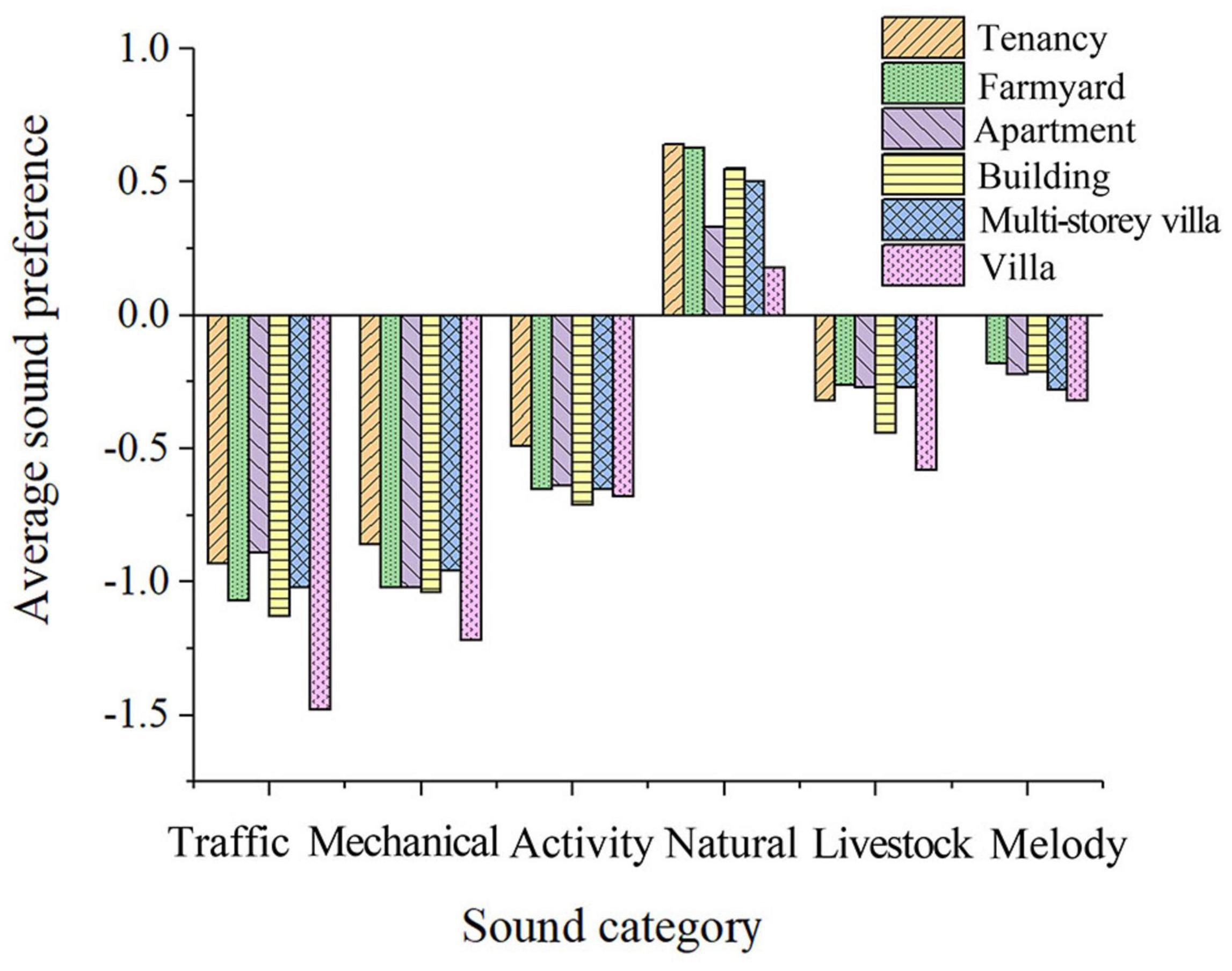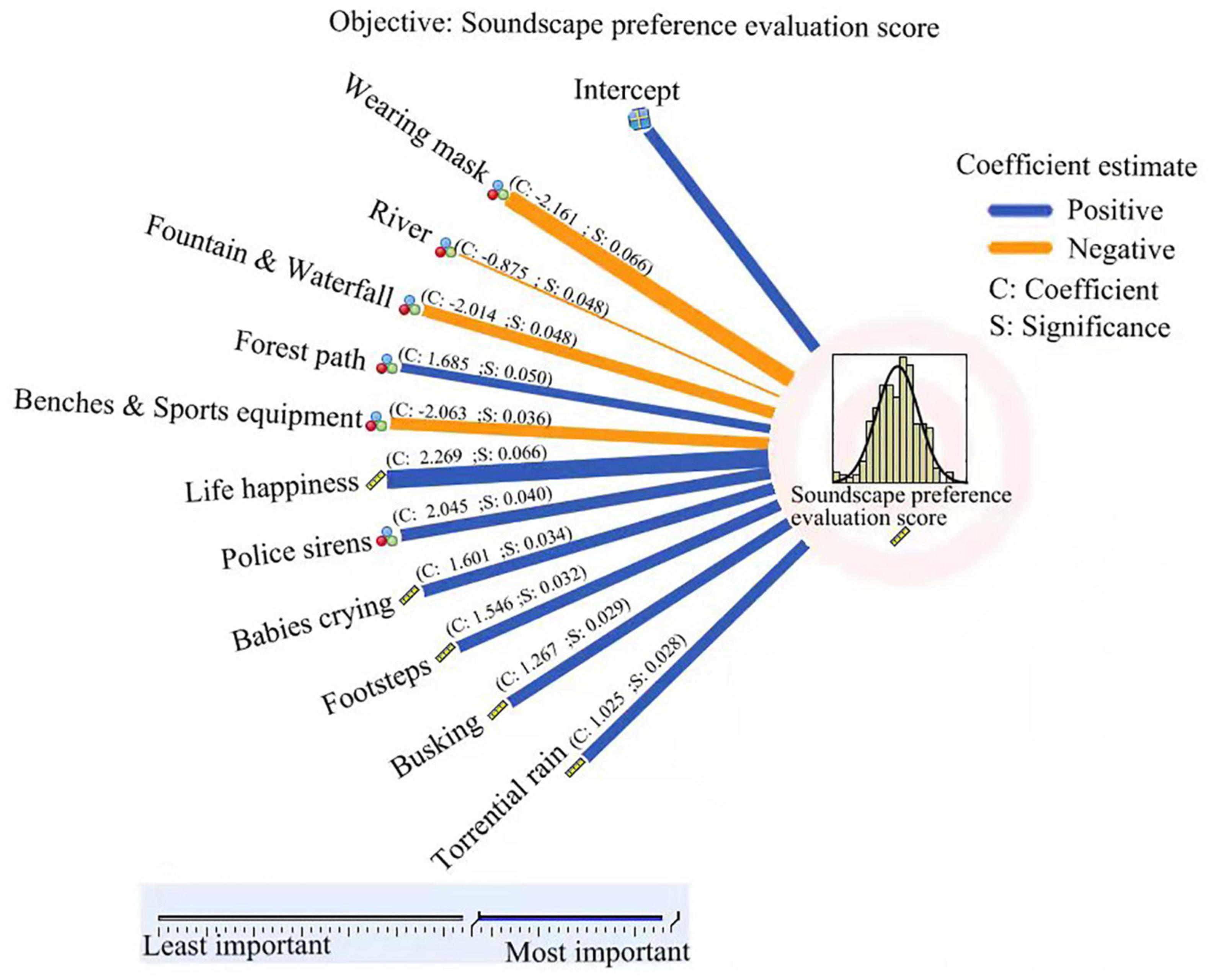- 1Department of Tourism Management, South China University of Technology, Guangzhou, China
- 2State Key Laboratory of Subtropical Building Science, Guangzhou, China
- 3Guangdong Tourism Strategy and Policy Research Center, South China University of Technology, Guangzhou, China
- 4Xi’an Liangjiatan International School, Xi’an, China
This research aims to explore the reality of the soundscape preferences of Chinese urban residents in general public landscape in the post-pandemic era, and then to propose design recommendations to meet the practical needs of people’s preferences for landscape—especially soundscapes—in the post-pandemic era. In this study, we utilized the subjective evaluation method to conduct an online questionnaire in 29 Chinese provinces which experienced severe pandemic caseloads and collected 860 valid responses. This study revealed people’s preference for landscape and soundscape in the post-pandemic era. We further studied the correlation between landscape preference and soundscape preference, analyzed the influence of living conditions on soundscape preference, founded the effects of personal characteristics and living conditions on soundscape preference, and explored the strongest influence factors on soundscape preference through the establishment of automatic linear model. The results revealed a positive correlation between life happiness and soundscape preference, whereas wearing masks significantly reduced soundscape perception ratings and people who have been vaccinated are more tolerant of various noises. Moreover, based on these analysis results, the design recommendations on landscape (overall landscape, plant, and tour space), soundscape construction of caring for vulnerable groups (teenagers and children, elderly people, and disabled and unhealthy) has been discussed.
Introduction
The novel coronavirus pneumonia (COVID-19) is the most impactful and deadly global public health event in the world in the past 100 years (Xu, 2020). Many countries around the world have chosen lockdown and restrictions on people’s mobility (home and community isolation) as the main strategies to combat the COVID-19 pandemic. These policies have increased residents’ psychological anxiety and have caused harm to their physical and mental health (Liu et al., 2020). These actions have significantly modified urban soundscape, opening up an unprecedented opportunity for research in soundscape field (Asensio et al., 2020). Under the influence of pandemic, urban residents’ desire for tourism, fitness, and leisure has increased, and residents have shown a strong physical and mental demand for urban public landscape (Wang et al., 2020; Lenzi et al., 2021), meanwhile, urban public landscape is facing substantial challenges as a result of the measures taken to limit the spread of the virus (Fu et al., 2020). It is a topic for reflection whether and what changes have taken place in people’s soundspace preference in the urban public landscape in the post-pandemic era (Chen and Bai, 2021). In the pandemic and post-pandemic era, the change in the soundscape preference in general landscape space has become an essential factor to consider when designing public space. The preference for landscape and soundscape will continue to evolve as the pandemic continues and actions are taken to prevent its spread. This article aims to explore the reality of the soundscape preferences of Chinese urban residents in general landscape spaces under the influence of COVID-19 and then to propose design recommendations to meet the practical needs of people’s preferences for landscape—especially soundscapes—in the post-pandemic era.
At present, the pandemic has put forward new requirements for the landscape and soundscape design of urban public spaces. Urban public space refers to the open space between architectural entities in a city or urban environment, mainly contains natural environments, such as mountains, forests, water systems, as well as artificial parks and green spaces, it is used for urban residents to conduct public communication and hold various life and social activities (Carr et al., 1993; Xi, 2021). At present, few method based on soundscape design was adopted for visual-centered tendency in landscape plan (Lian et al., 2020), but a large number of studies have shown that soundscape has a critical impact on people’s viewing experience (Zhang, 2014; Kogan et al., 2021). Soundscape design attempts to discover principles and to develop techniques by which the social, psychological, and esthetic quality of the soundscape may be improved (Alfredo et al., 2014; Kogan et al., 2021). Soundscape (acoustic environment perceived and understood by an individual or society) can impact human health (Aletta et al., 2018a), and an upbeat soundscape is often associated with faster stress recovery and better self-reported health status (Kang, 2006; ISO, 2014; Aletta et al., 2018b; Liu et al., 2019a). Studies have found that natural sound can reduce the human heart rate (HR), respiratory frequency (RF), and respiratory depth (RD) (Li and Kang, 2019), natural sounds—such as bird songs—can reduce anxiety, relieve stress, and promote emotional stability (Annerstedt et al., 2013). Acoustics also has a significant impact in the medical and health field (Baird and Samson, 2015). Therefore, pleasant sounds can enhance people’s viewing experience in an urban environment (Aletta et al., 2018a,b; Liu et al., 2019a). So far, many scholars have conducted detailed studies on cities (Zhang, 2016), villages (Ren, 2016), airports (Kitapci and Galbrun, 2019), and commercial spaces (Song et al., 2011; Meng and Kang, 2018), urban pedestrian streets (Yu et al., 2014) and historical districts (Zhou et al., 2012), etc. Although emerging studies have discussed the potential benefits of soundscape in mental restoration, few have investigated how soundscape renews and re-energizes people, especially in the face of the current public challenge of the COVID-19 crisis. In view of the pandemic, a moderated mediation model to reveal that natural soundscapes have great restorative benefits for visitors (Qiu and Zhang, 2021); a set of descriptors is outlined which better enables the application of more novel approaches to the evaluation of the effect of this new soundscape on people’s subjective perception under the pandemic (Asensio et al., 2020). A case study of the human perception of environmental sounds in an urban neighborhood, discussed how such changes in the acoustic environment of the site under the pandemic (Lenzi et al., 2021). An online survey administered to 464 home workers in January 2021 in London, utilized a previously developed model for the assessment of indoor soundscapes to describe the affective responses to the acoustic environments (Torresin et al., 2021). These new literature make many ground-breaking contributions to the soundscape of the pandemic, and these results influence the further exploration of urban public space soundscape and the consideration of questionnaire questions in this study. However, the research on soundscape preferences in urban public landscape in the pandemic and post-pandemic era requires additional exploration. Under the demand of both pandemic prevention and leisure and fitness, exploring the residents’ preference for urban general landscape and soundscape can guide the urban public landscape design in the post-pandemic era.
To achieve this result, this study used the subjective evaluation method to conduct an online questionnaire in 29 Chinese provinces with a high incidence of COVID-19 cases, from which 860 valid questionnaires were collected. This study revealed people’s preference for landscape and soundscape after the pandemic, studied the correlation between landscape and soundscape preference, analyzed the influence of living conditions on soundscape preference, founded the effects of personal characteristics and living conditions on soundscape preference, and explored the strongest influence factors on soundscape preference through the establishment of automatic linear model. The main findings of the study revealed the direct impact of epidemic prevention measures on soundscape evaluation, summarized the main influencing factors of soundscape preference in the post-pandemic era, found the impact of individual factors on soundscape evaluation under the pandemic influence. Moreover, based on these analysis results, the design recommendations on landscape (overall landscape, plant, and tour space), soundscape construction of caring for vulnerable groups (teenagers and children, elderly people, and disabled and unhealthy) has been discussed.
Methodology
This study adopts theoretical research-question, investigation-data, analysis-proposed, and strategy research-design recommendations (Figure 1). Based on the concept and academic background of urban public space soundscape preferences, a questionnaire surveyed urban residents within 29 Chinese provinces with a high pandemic incidence to study the soundscape preferences of general landscape spaces in the post-pandemic era.
Research Area
To ensure the comprehensiveness of the questionnaire, the study mainly selected Hunan Province (29.81%, 256 responses), Guangdong Province (11.86%, 102 responses), Hubei Province (8.56%, 74 replies), Hainan Province (7.65%, 66 responses), Zhejiang Province (5.02%, 43responses), Hebei Province (4.40%, 38 responses), and an additional 23 provincial most severely infected administrative regions. Among them, Hubei Province is the most seriously affected by the pandemic. In total, 860 valid questionnaires were collected. The distribution and proportion of questionnaires in each province are shown in Figure 2.
Survey Object and Questionnaire Design
To ensure scientific rigor, this study uses questionnaires to conduct soundscape perception research (Ren et al., 2012, 2015; Meng and Kang, 2018; Pickens et al., 2019). This method is more suitable for research on the subjective evaluation of a population. We conduct a random sampling survey of people aged 10–60 who (have normal sound hearing) can subjectively evaluate public landscape and soundscapes in selecting survey subjects. The proportion of the essential characteristics of the respondents is shown in Figure 3.
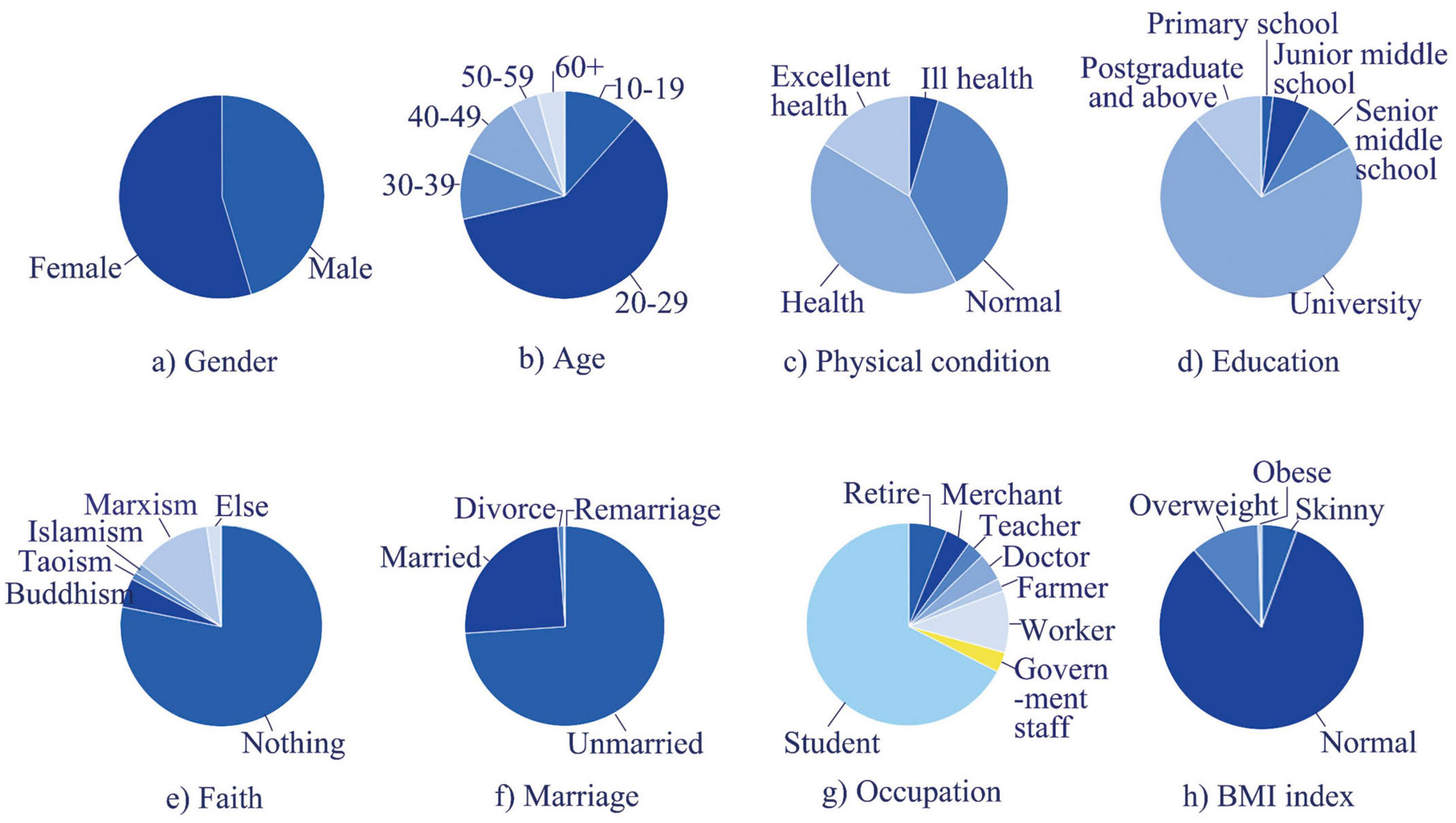
Figure 3. Distribution of essential characteristics of respondents. BMI is a commonly used index to measure the degree of obesity and health in the world. The average value of BMI is between 20 and 25, more than 25 is overweight, and more than 30 is obesity. (a) Gender. (b) Age. (c) Physical condition. (d) Education. (e) Faith. (f) Marriage. (g) Occupation. (h) BMI index.
The survey was conducted during a relatively stable time in the pandemic and post-pandemic era within China, from January to February 2021. This period is the Chinese New Year holiday; as such, people have more free time for exercise, leisure activities, and stress reduction than usual.
The research uses “Questionnaire Star” as the research tool. “Questionnaire Star” is a professional online questionnaire platform in China, which has been used to conduct more than 120 million questionnaires. We use random sampling to generate a QR code and distribute the questionnaire through WeChat.
This study summarized literature to produce 65 questions to survey the overall soundscape preferences of the respondents on three parts: the basic situation of the respondent (question 1-18), the landscape preference and overall feeling (question 19–30), and the soundscape preferences (question 35–64). The basic information of the respondents includes gender, age, occupation, annual family income, personal health, whether they have been infected with the coronavirus, and whether they have been vaccinated against the coronavirus. Questions about the surrounding greening environment were designed to investigate the greening rate, distance to the nearest green space, and the frequency of public landscape space use in the post-pandemic era. After the pandemic, the general landscape space preference includes several common public landscape space types, such as business districts, streets, squares, grasslands, forests, rivers, seashores, and fields (Guo, 2010). The comprehensive questionnaire is mainly designed to evaluate the preference of the soundscape. According to the ecological and semantic nature of the soundscape, the evaluation divides the sounds into six categories: traffic sounds, mechanical sounds, human activity sound, natural sound, livestock sound, and melody (Brown et al., 2011). Moreover, the Likert five-level scale was used to give evaluation levels for the soundscape: −2: immensely dislike, −1: dislike, 0: no preference, 1: like, and 2: immensely like (Zube, 1984). In addition, in order to avoid order effect, the second group (question 19–30) and the third group (question 35–46), When the respondents answer the questions in the “Questionnaire Star” mobile applet, the questions order will be randomly selected in group. Moreover, for the third group (question 35–46), half of the survey questions option is random adjustment has become from “2: immensely like, 1: like, 0: no preference, −1: dislike, and −2: immensely dislike”, while the other half the survey questions option order are “−2: immensely dislike, −1: dislike, 0: no preference, 1: like, and 2: immensely like”.
Appear with each question, audio is played (35 groups of sounds, 3 s each) to ensure that the respondent receives the same sound when making an evaluation (Ren et al., 2015); Before the questionnaire was distributed, 20 people were tested, the total average time to fill in the questionnaire is about 5 min (5 s to answer a question on average), it is considered reasonable to answer the questionnaire for no more than 10 min (Meng and Kang, 2018); a progress bar is provided to check the progress of the questionnaire. Furthermore, there is a lottery at the end of the questionnaire designed to increase the enthusiasm for participating and sharing. To remove invalid questionnaires and improve the survey’s reliability, two questions are designed (e.g., please select 0) to eliminate weak responses (Ren et al., 2012).
Reliability and Validity Analysis of Questionnaire
The reliability and validity of the questionnaire data were tested using SPSS26.0 software. The research uses Cronbach α to analyze the reliability of the questionnaire. Literature suggests that if the value of Cronbach α is above 0.5 to 0.6, the results are reliable (Lu, 2004). The calculated responses of the questionnaire all meet this reliability standard: traffic machinery (0.835), human activity sound (0.879), natural sound (0.857), livestock sounds (0.889), and music (0.799). The overall perception factor reliability is 0.926. It can be concluded that the reliability of this questionnaire meets the survey requirements. To test the validity of the questionnaire, the study applied factor analysis to test the validity of KMO. The result was 0.907, which satisfies the conditions for factor analysis (KMO ≥ 0.6) (Lu, 2004), indicating that the validity of the questionnaire also meets the requirements. The Bartlett sphere test approximates the chi-square value of 9252.826, which corresponds to a probabilistic value of 0.000 (P < 0.01), suggesting that the questionnaire has a significant correlation and that its analytical data is valid.
Results
Soundscape Preference Overview in the Post-pandemic Era
As shown in Table 1, the most preferred sounds of urban residents in public landscape spaces in the pandemic and post-pandemic era are the sound of natural flowing water (0.89), wind blowing leaves (0.82), bird songs (0.77); popular music (0.32), heavy rain (0.31), temple bells (0.28), wedding music (0.09) and festival singing and dancing (0.03), indicating that people prefer natural sounds and music in public landscape spaces. The results of previous studies support these findings (Kang and Yang, 2002; Liu et al., 2019b).
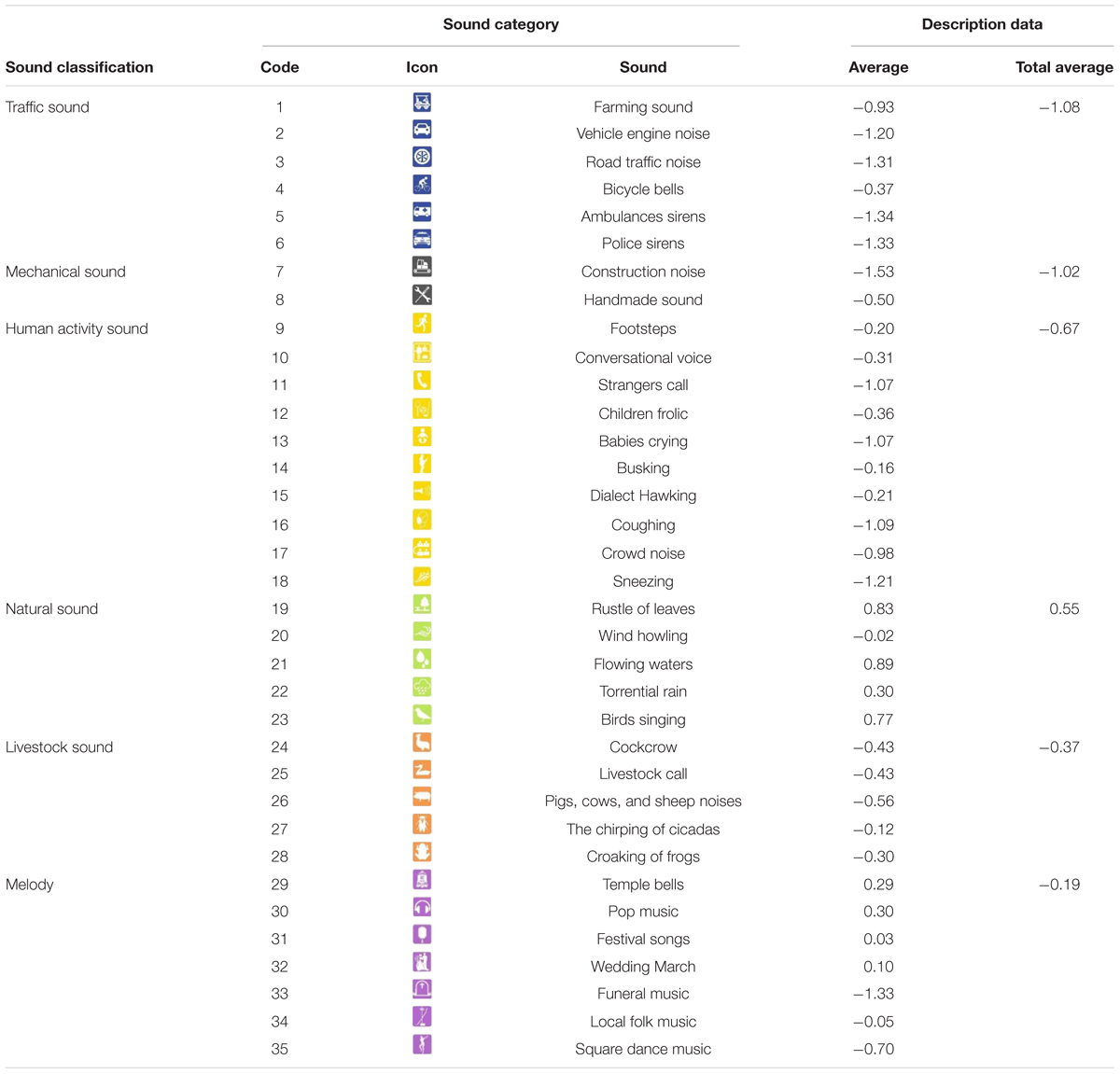
Table 1. Average description of overall soundscape preference of Chinese urban residents in public space under the pandemic situation.
The sounds that are highly disliked by urban residents include construction noise (–1.54), ambulance sounds (–1.34), funeral music (–1.33), police car sirens (–1.33), and road traffic noise (–1.31). These results are similar to previous conclusions (Zhang et al., 2018). However, it is worth noting that people’s sensitivity to emergencies and deaths has increased under the influence of the pandemic, and the aversion of ambulance sounds, funeral music, and police car sirens is significantly higher than the noise of road traffic. Studies have shown that people’s preferences often do not lie in the sound itself but their positive or negative emotions. Some long-term soundscape memories are preserved, which will produce different soundscape emotions (Liu and Kang, 2016). The conclusion further verified that positive or negative feelings brought about by sounds impact the degree of soundscape preference and that in the pandemic and post-pandemic era, specific sounds can have a particularly negative effect on people’s psychological perception, the specific data is shown in Figure 4.
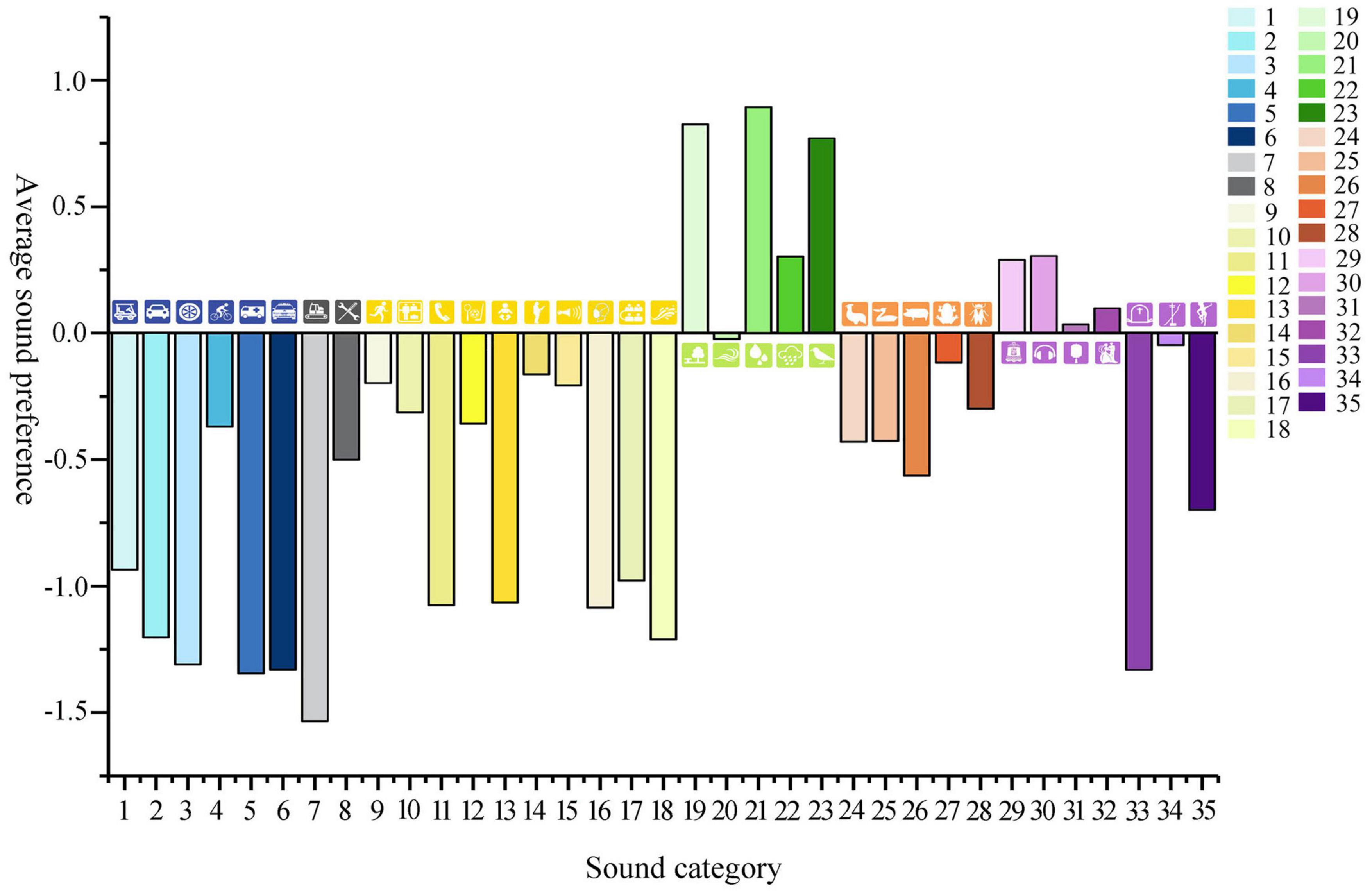
Figure 4. Columnar distribution of the mean value of soundscape preference (code is shown in Table 1).
Correlation Between Landscape and Soundscape Preference in the Post-pandemic Era
According to the correlation analysis (Tables 2, 3), the type of public landscape space, landscape structural design, and water landscape all affect the subjective evaluation of soundscape. In terms of overall landscape perception, those who prefer commercial areas demonstrate relatively acceptable to the sound of police car sirens. Still, they prefer the sound of children’s frolicking, babies crying, frogs, cicadas, wind blowing leaves, birds, chickens, and square dancing. People who prefer in urban environments have a higher degree of preference for square dances and a relatively lower degree of preference for natural sounds. Those who prefer rural areas—grasslands, woods, mountains, rivers, seaside, and field landscape—show preference for natural sounds, sounds of livestock, children’s frolicking, and farming work have a higher degree of preference.
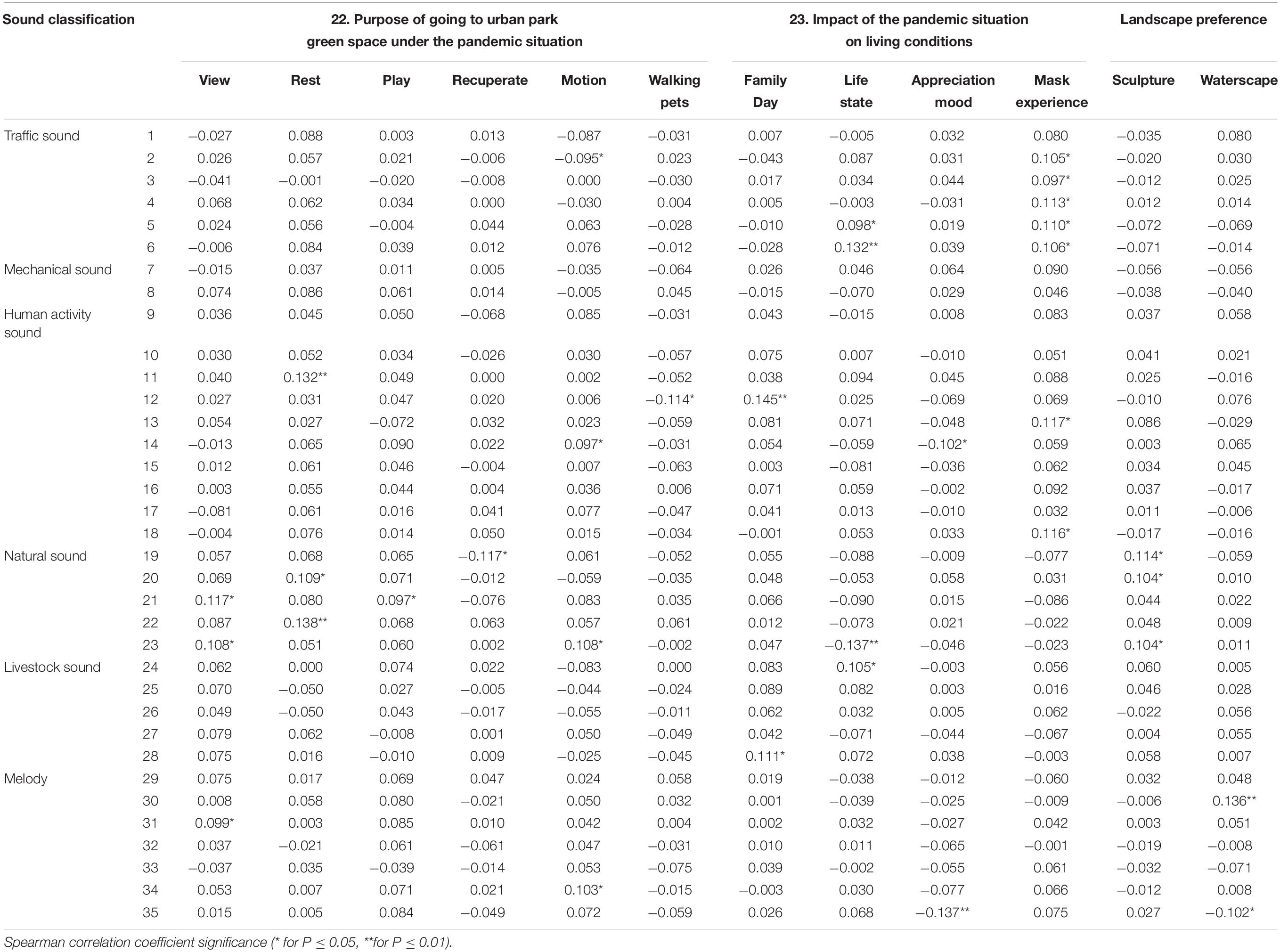
Table 2. Correlation between public landscape space preference and soundscape preference under pandemic situation (code is shown in Table 1).
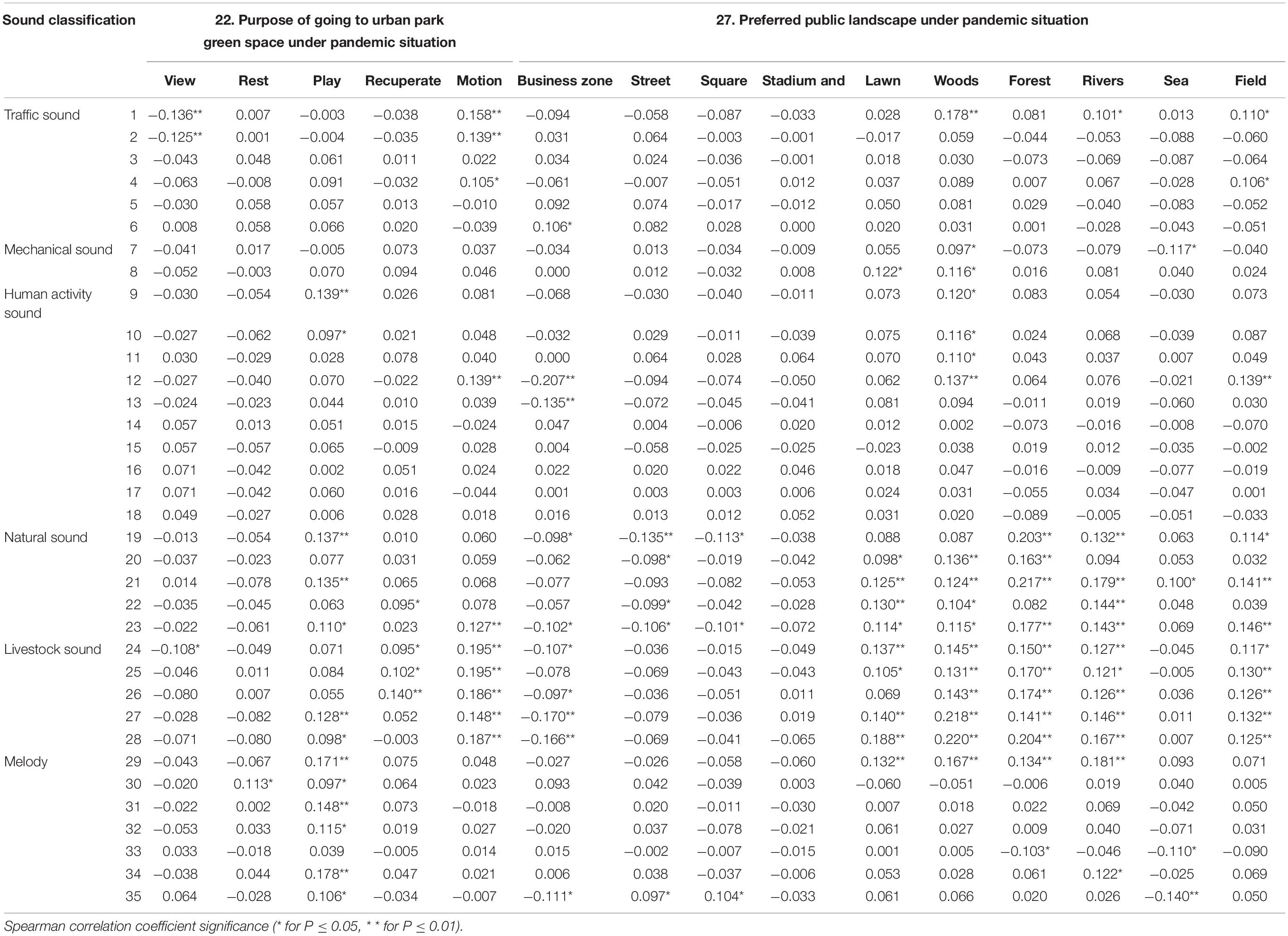
Table 3. Correlation between public landscape space preference and soundscape preference 2 (code is shown in Table 1).
In the selection of landscape structural design, those who use walkways have a relatively low preference for the sound of wind blowing leaves, while respondents who prefer water pavilions, waterside trails, and forest paths have a higher preference for the sound of wind blowing leaves. Individuals who prefer forest paths have a relatively high preference for the howling of the wind, while those who favor sports and benches have a low preference. In terms of water landscape preferences, those who favor the sea have a higher preference for pop music while individuals who prefer fountains are more receptive to the sound of square dancing.
Data analysis shows that wearing a mask has a significant impact on the correlation of soundscape preferences. The results show that if low numbers of people wear masks while viewing the scenery, there is a lower preference for the sounds of traffic, mechanical sounds, and stranger calls, babies crying, coughing, and sneezing. Conversely, people who wear mask when viewing the scenery will give a relatively lower soundscape evaluation on the noise.
On the whole, soundscape preference is inseparable from the environmental conditions and the atmosphere created by the public landscape space. Visual landscape preference indirectly affects the overall soundscape preference through the perceived incidence and loudness of sound (Liu et al., 2019b). The results verify that people’s subjective evaluations of soundscapes are closely related to the soundscape conditions that typically appear in specific environments and the usual atmosphere. In the case of a long-term pandemic, public landscape designers need to consider the impact of wearing masks on people’s perception of soundscapes.
Influence of Living Conditions on Soundscape Preference in the Post-pandemic Era
The results (Table 4) show that the greening rate (19), the distance (20) of the green space, and the frequency of going to the public green space are related to the purpose (21) and the degree of soundscape preference. Based on the correlation results obtained, it can be inferred: in terms of greening rate, the higher the surrounding greenery, the higher the degree of people’s preference for industrial noise, farming work, chicken crows, and vehicle engine noise. In terms of green space distance, the closer the residents are to the green space, the higher the tolerance for strangers’ calling, people clearing their throats, and ambulances. In terms of the frequency of going to the green space, the higher the frequency of going to the green space, the more people like the sound of livestock. This may mean that green spaces can bring people closer to nature, therefore people prefer animals more. In general, the results of this study combined with the theory of stress reduction and the theory of attention recovery (Wen, 1989), can further speculate that the surrounding greening rate can relieve people’s stress and fear in the post-pandemic era in the city.
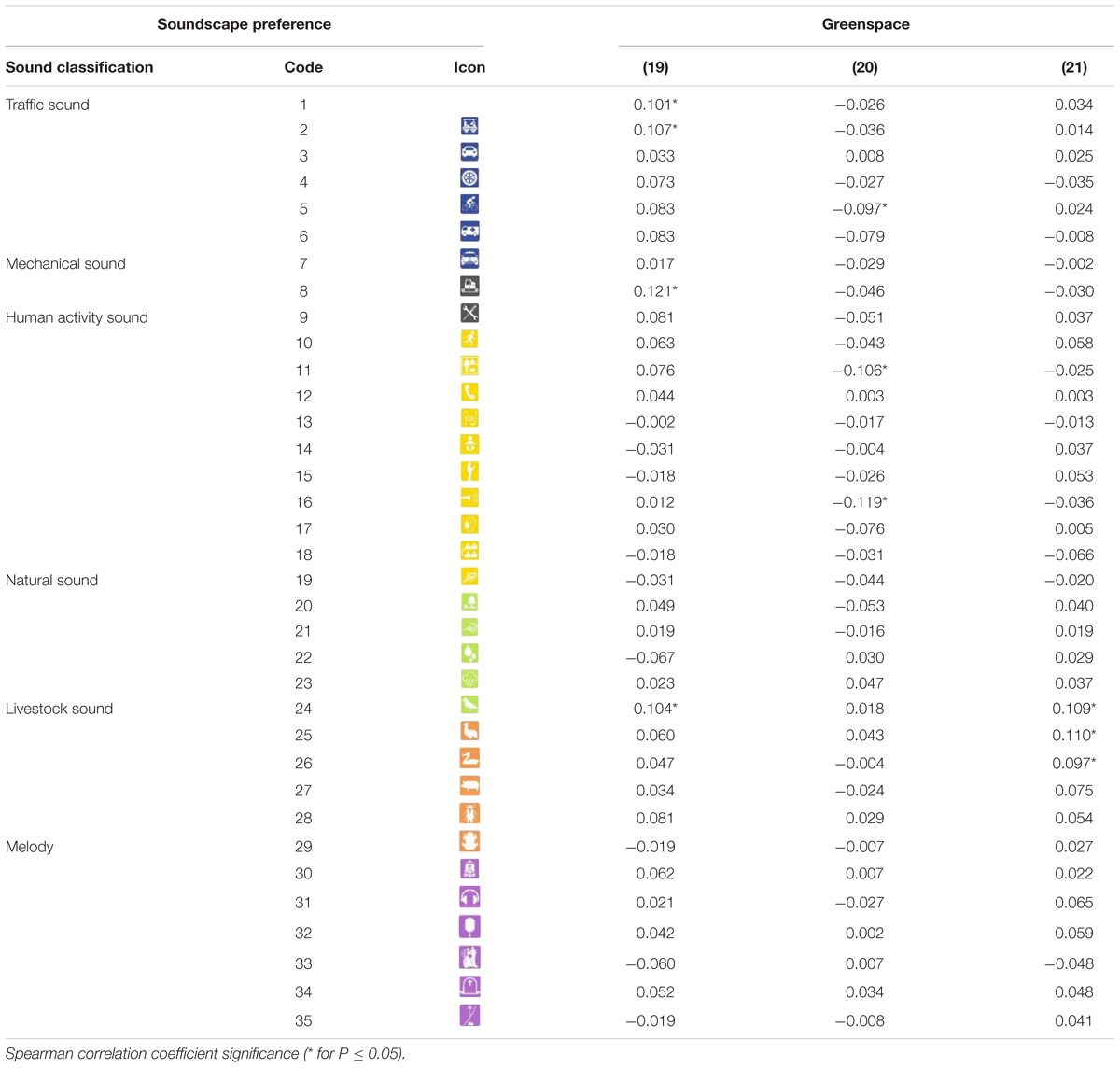
Table 4. Correlation between personal living conditions and soundscape preference (code is shown in Table 1).
The Influence of Other Factors on the Soundscape in the Post-pandemic Era
Personal Characteristics
Gender
This study found that gender has a negligible effect on soundscape preference in the post-pandemic era, which is consistent with the results of previous studies (Yu and Kang, 2010). The results (as shown in Figure 5) show that men have a lower preference for square dance sounds than women, but they have a higher acceptance of howling winds. In China, square dance activities are dominated by women, and women are more sensitive and emotional than men, this also provides an explanation to why woman’s soundscape preference for the wind and whistling sounds is lower for men (Meng et al., 2010).
Age
According to related studies, age and soundscape preference are significantly correlated (Meng et al., 2010; Aletta et al., 2019). It can be seen from Figure 6, that the respondents’ age is positively correlated with natural sounds such as the sound of people’s activities in the post-pandemic era, the sound of wind and leaves, running water, domestic animals, festival songs and dances, and the sound of local folk music; but it is negatively correlated with pop music. This suggests that as residents grow older, their evaluation of the soundscape of human activities, natural sounds, domestic animal sounds, and music increases while their auditory preferences of pop music decreases. These results are consistent with the results of previous studies (Zhou et al., 2012). This result suggests that the older adults favor children and conversation over other auditory stimuli in the post-pandemic era.
Occupation
According to the correlation analysis, it is found that occupational factors have a significant impact on the subjective evaluation of soundscape preferences. As shown in Figure 7, doctors, retirees, and teachers have relatively high preferences for human activity sounds, natural sounds, and music, while workers and government workers have low preferences for human activity sounds and natural sounds. Retirees have the highest preference for the sound of wind blowing leaves. Students have a lower preference for the sound of domestic animals, babies crying, local folk music, and square dancing. The results suggest that professionals who have more contact with people—such as doctors and teachers—generally have a higher tolerance for acoustic disruptions than other occupations and that migrant workers, government workers, and students have fewer soundscape preferences in the post-pandemic era.
Faith
As shown in Figure 8, Islamic people have a lower degree of preference for the sound of pigs, cattle, and sheep, while Marxists have a lower degree of preference for the sound of howling wind. Respondents who do not identify as religious have a highest preference for popular music while those who identify as Buddhists and Marxists have the lowest. Islamic practitioners’ preference for funeral music is higher than that of other religious believers. Religious ideology impacts the degree of soundscape preference; it is possible that the living habits and specific religious belief of an individual can indirectly affect the evaluation of soundscape in the post-pandemic era.
Education
As shown in Figure 9, the level of education is negatively correlated with the soundscape preferences of square dances, livestock sounds, wedding music, children’s frolicking, babies crying, farming operations, and vehicle engine sounds in the post-pandemic era. This study supports the conclusion that the higher the level of education, the lower their soundscape preferences and comfort (Meng et al., 2010).
Marriage
As shown in Figure 10, married people have a higher preference for conversation, children’s frolicking, and baby crying, while unmarried people have a lower preference for cock crowing in the post-pandemic era. The surveyed results suggest married people are more tolerant of crowds and children and that they are more inclined to social gatherings than unmarried people.
Number of Children
As shown in Figure 11, with the increase in the number of children, people’s preference for children’s frolicking, human speech, domestic animal sounds, square dances, and local folk music increases. This result may reveal that families with more children are more likely to participate in social activities in the post-pandemic era.
Family Housing Situation
According to the correlation analysis, the annual household income has no significant impact on the soundscape preference evaluation. Still, the family housing situation is correlated with soundscape preferences (Figure 12). The results show that the better housing conditions are, the lower the tolerance for acoustic disturbances. However, individuals who rent houses and villas have a high degree of preference for children’s frolicking, in contrast, residents living in white-collar apartments and high-rise buildings have less preference for children’s frolicking. It may be revealing that young working-class people have increasing economic and reproductive pressures, and have a lower preference for children in the post-pandemic era.
Overall, under the impact of COVID-19, in terms of personal characteristics, family environment, age, occupation, education, and family housing are the main factors affecting soundscape preference. Gender, beliefs, marriage, and other factors have a certain degree of influence on auditory preference. Physical condition, BMI, annual family income, and the number of people in the family have no significant impact on soundscape preferences in the post-pandemic era.
Life State Under the Impact of the Pandemic
The Impact of Vaccination
To explore whether the COVID-19 vaccination impacts the preference of the soundscape, this manuscript analyzes the correlation coefficient and significance level of the Chinese respondents’ vaccinations of the vaccine (12) and the preference of the soundscape (Table 5).
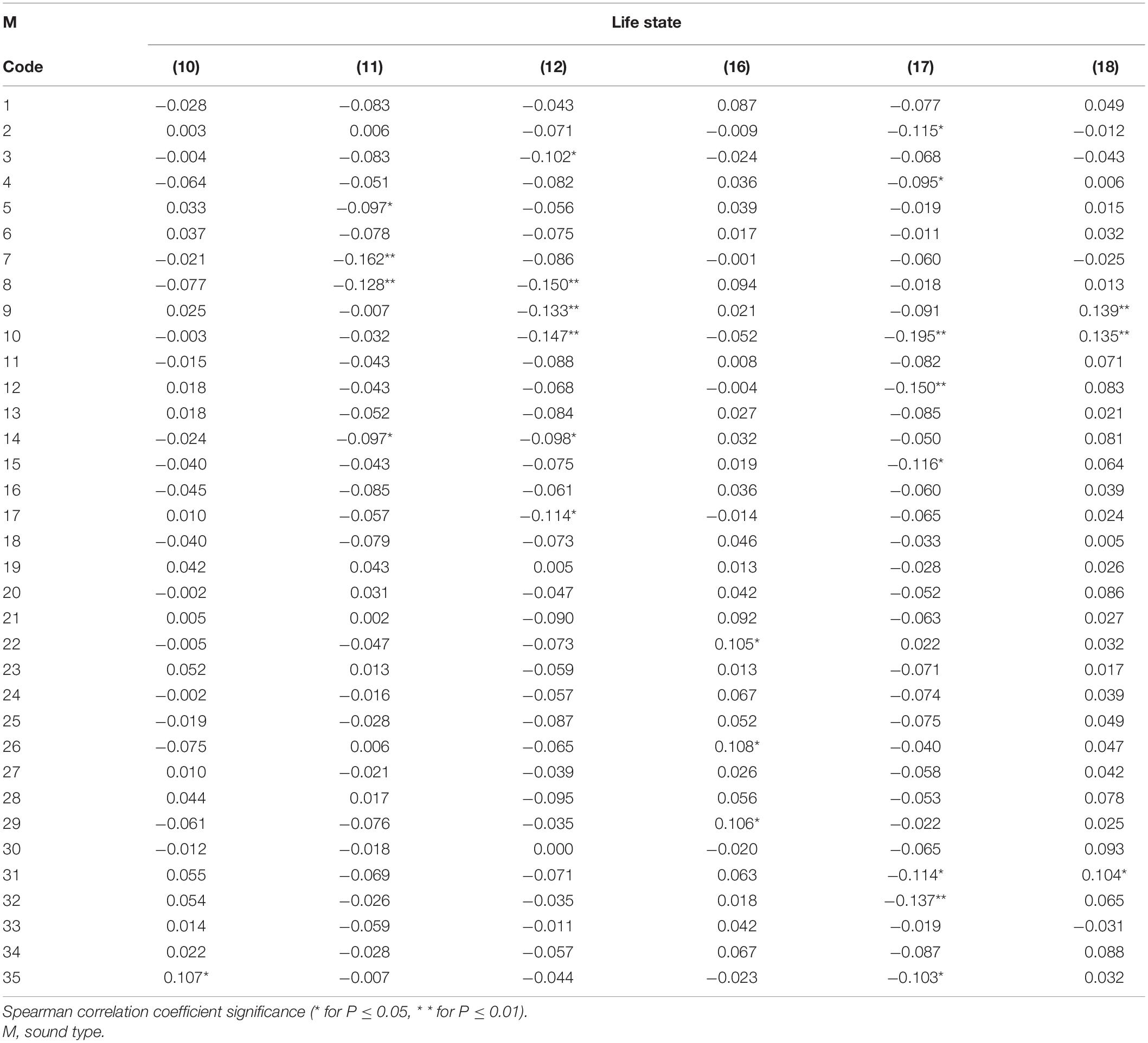
Table 5. Correlation between life state and soundscape preference in the post− (code is shown in Table 1).
(10) Compared with before the pandemic, has your BMI changed?
(11) Have you been infected with COVID-19?
(12) Have you and your family or friends infected with COVID-19?
(17) Compared with before the pandemic, do the soundscapes make you feel more nostalgic?
The study found that people have a lower preference for ambulances and construction noise regardless of whether they are vaccinated with the vaccine. The pandemic has caused many deaths and illness and has caused an increase in people’s sensitivity to grief events and noise. Interestingly, the injection of the vaccine brings people a sense of psychological security. The results show that vaccinated people have a slightly higher preference for road noise, handicraft noise, throat coughing, live street performances, and wind whistling sound than unvaccinated individuals. Furthermore, they have a slightly higher preference for human footsteps as well as for having conversations in the post-pandemic era.
Influence of Hometown Attachment and Happiness
After investigating whether respondents reside in their hometown, their attachment to their hometown, and the happiness in their life, this article finds that soundscape preference is somewhat affected by homesickness and joy. The results show that people who reside in their hometown have a higher preference for the sound of heavy rain, livestock, and temple bells, while respondents who feel nostalgic toward their hometown have a higher preference for the sound of vehicle engines, human conversations, children’s frolicking, festive singing, and dancing. Individuals who identify as having high happiness in their lives have a high degree of preference for wedding music and square dance sounds. Their preference for the sound of human footsteps, human conversation, festival singing, dancing, and local music and art is also higher than those with lower happiness levels. This is consistent with previous studies which have suggested that people with higher happiness are more likely to report positive soundscapes. Conversely, people with lower happiness levels are more likely to have negative attitudes toward the sound environment (Aletta et al., 2019). It can be inferred that happiness and hometown attachment can increase an individual’s soundscape evaluation in the post-pandemic era.
The Influence of Socioeconomic Status on the Perception of Soundscape
The socioeconomic status of an individual or family is often considered comprehensively based on factors such as income, education, and occupation (Wen, 1989). Evidence suggests that the better the family’s housing situation, the lower the degree of people’s preference for noise such as traffic sounds. In the post-pandemic era, it is worth noting that among those with a high socioeconomic status, individuals who live in villas and those with extreme affluence have a high degree of preference for the sound of children’s frolicking. In contrast, residents who live in white-collar apartments and high-rise buildings have less preference for the noises of children’s frolicking. The higher the level of education, the higher preference for most music and human activity sounds—especially children’s frolicking and babies crying—while preference for livestock sounds and traffic noise is lower. In terms of occupation, doctors and teachers have a relatively high preference for human activity sounds, natural sounds, and music. Government workers have a low preference for human activity sounds and natural sounds.
Overall, It can be inferred that the higher the socioeconomic status, the lower the tolerance for noise. With the different attributes of different occupations, the soundscape preferences of people with high socioeconomic status are more targeted, which is related to the nature of their careers in the post-pandemic era.
Soundscape Preference of Vulnerable Groups
Soundscape Preference of the Elderly
The elderly people are prominent participants in the public landscape space, and their preference for soundscape landscape is a critical indicator of soundscape optimization. At present, scholars have researched the auditory needs of the elderly and found that they prefer natural sounds and stimulating music (Wang and Kang, 2020). However, their preference is often affected by the type of activity in which they are participating. For example, when playing ball or sitting they tend to prefer sound while when they are playing or watching chess, they do not want to hear any sounds, including soothing music. On the whole, amongst the elderly there is a significant positive correlation between the general sound environment and the preferences for additional natural sounds (Wang et al., 2020). This study shows that people aged 50–59 and over 60 have a high preference for human activity sounds, natural sounds, domestic animal sounds, and music. They have a low preference for pop music sounds under the influence of the pandemic.
Soundscape Preferences of Teenagers and Children
Studies have shown that the soundscape of urban parks can promote children’s psychological and physiological recovery (Shu and Ma, 2020). Therefore, the soundscape preference of teenagers and children is essential when considering soundscape design in environments with many adolescents. The results of this study show that teenagers have a higher preference for the sound of wind blowing leaves, running water, bird songs, festive singing and dancing, and pop music. Under the influence of the pandemic, they have a high preference for the sounds of footsteps, conversations, children’s frolicking, and babies crying, besides, the soundscape preference for the sounds of chickens, domestic animals, cicadas, frogs, and square dancing are relatively low. This suggests that adolescent soundscape preferences are biased toward soothing natural sounds and modern music and are not interested in human activities, domestic animal sounds, and natural sounds and traditional music in the post-pandemic era.
Soundscape Preferences of Unhealthy and Obese People
The survey results show that, under the influence of the pandemic, people in poor physical condition (9) have a higher preference for the sound of wind blowing leaves, while obese people (10) have a higher preference for square dancing. This suggests that unhealthy people desire the related healing effect of natural sound, while obese people have the desire to do outdoor-related exercise under the influence of the pandemic.
In general, the elderly people, adolescents, and unhealthy people have a higher preference for natural sound, especially the elderly. The soundscape preferences of teenagers and children are more inclined toward popular music. Obese people have a higher preference for square dancing—perhaps due to their desire for exercise. The Soundscape preferences of disadvantaged groups are affected by their own psychological and physical requirements, and the soundscape can alleviate their physical and mental needs to a certain extent in the post-pandemic era.
Automatic Linear Model of Soundscape Preference in the Post-pandemic Era
To further analyze the preference of soundscape, the automatic linear model is applied with SPSS26.0, andsoundscape preference evaluation is divided into the target variable. The relationship between 52 other predictive variables is shown in Figure 13.
In the overall factors, happiness and the soundscape preference for the personal assessment show a strong positive correlation. It can be assumed that if the pandemic reduces people’s happiness, it will directly force the soundscape preference to decrease, which indicates that the pandemic has a weakening effect on soundscape preference. In addition, it is found that people who like the landscape of the forest path, more sensitive to the sound of police sirens, babies crying, footsteps, busking, and torrential rain have a higher soundscape preference evaluation score in the post-pandemic era.
In particular, it can be inferred that people who are unwilling to wear a mask to enjoy scenery have a relatively higher total subjective evaluation score. This suggests that wearing masks directly reduces people’s evaluation of soundscape, revealing that the epidemic affects soundscape evaluation in another way. In addition, it is found that people who like water environment—with preference for rivers, fountains waterfalls—had a negatively correlated soundscape evaluation in the post-pandemic era. This may be because people who like water scenes tend to be quiet and reflective, rather than disturbed by other sounds. Moreover, this study found that people who like do leisure sports—with preference for benches and sports equipment—had a negatively correlated soundscape preference evaluation. This may be because people who enjoy leisure and exercise do not like to be disturbed, so they have lower soundscape evaluation score.
Conclusion
This study used the subjective evaluation method to conduct an online questionnaire survey in 29 Chinese provinces with high infection rates. By analyzing the correlation and reasons for different landscape and soundscape preferences, it was found that people with different attributes have different perceptions of landscape and soundscape in the post-pandemic era. The main findings are summarized as follows:
Direct Impact of Pandemic Prevention Measures on Soundscape Evaluation
Wearing Masks
Among common quarantine measures during the pandemic, wearing masks significantly reduced soundscape perception ratings, especially for sounds that people did not like before the pandemic, such as traffic, babies crying, construction, and stranger calls. People also show great aversion to audible hints of possible infection, such as clearing their throats and sneezing.
Vaccine
People who have been vaccinated are more tolerant of various noises. Their preference for road noise, handicraft noise, people clearing their throats and coughing, live street performances, and gale screaming is slightly higher than that of unvaccinated individuals. Their preference for human footsteps and human conversations is higher, revealing that they showed relative trust and security toward strangers.
Main Influencing Factors of Soundscape Preference in the Post-pandemic Era
Main Influencing Factors
The study confirms that the overall soundscape preferences of urban residents in public spaces were affected by the pandemic. The results revealed natural sound and music have the highest overall impact on soundscape preference, whilst the overall value of soundscape preference for traffic sounds is the lowest. Among the natural sounds, the top 3 preference are natural running water, wind blowing leaves, and bird song.
Impact of the Epidemic
Under the pandemic situation, people show high sensitivity to emergencies and deaths, which affects the evaluation of soundscape preferences to a certain extent. Ambulance sounds, funeral music, and police car sirens accounted for higher aversion than road traffic noise which are usually the least preferred.
Impact of the Landscape
Under the influence of the pandemic, people’s subjective evaluation of soundscape is closely related to the landscape. Public landscape space type, landscape structure design, and water landscape are the three most important landscape factors that affect the soundscape preference, which reaffirms that people can indirectly affect the overall sound landscape preference through the spectrum and loudness of perceived soundscape.
Impact of the Greening Rate
In the post-pandemic era, the high correlation of data analysis shows that increasing the greening rate can improve the evaluation of sound landscape to a certain extent, and the closer the distance between residents and green space, the higher tolerance of noise to a certain extent. Moreover, people who visit green Spaces more often are likely to enjoy animals more.
Impact of Individual Factors on Soundscape Evaluation Under the Pandemic Influence
Main Influencing Factors
Among personal characteristics, age, occupation, education, and family housing are the main factors that affect soundscape preference. In contrast, gender, belief, marriage, and other factors have a secondary degree of influence on auditory preference. Physical condition, BMI value, annual family income, and the number of older people in the family do not affect soundscape preferences.
Disadvantaged Groups
The soundscape preferences of disadvantaged groups are often affected by their own psychological and physical needs. Some elderly people are fonder of physical activities, natural sounds, livestock sounds, and music. They express their yearning for the natural environment and lively crowds. Children’s soundscape preferences tend to be soothing natural sounds and trendy music which is more energetic. Obese people have a higher preference for square dancing due to their own fat loss needs in the post-pandemic era.
Life Happiness
In the overall subjective factors, life happiness and the soundscape evaluation for the personal assessment show a strong positive correlation.
Discussion
Based on the above conclusions, in this section, we presented some discussions on applying the findings to the design recommendations of urban public space in the post-pandemic era.
Design Recommendations of Landscape to Enhance Soundscape Experience in the Post-pandemic Era
Overall Landscape Design
The study found that the subjective evaluation of soundscape is closely related to the acoustic conditions of the place and the landscape. Within the overall landscape design, the integration of soundscape must be fully considered; a harmony can be created through architectural landscape structural design, waterscape, plant design, as well as other methods. The soundscape interacts with different landscape to form a good environment of audio-visual integration. Secondly, it is necessary to enrich the space with activities to guide people’s behavior and reduce people’s perception of unfavorable soundscape factors.
Green Environment Design
Studies have found that the greening rate, the distance to green space, as well as the purpose and frequency of public green space use, impacts soundscape preference. Previous studies have also found that increasing exposure to green plants can reduce stress, thereby affecting the soundscape evaluation. Green landscape, walkways, and trails can be set up to produce the sound of wind blowing leaves, thereby triggering people’s resonance with natural sounds. However, it is not suitable to set up a natural soundscape beside promenade, sports equipment, benches, and other sports and leisure facilities, which mainly emphasis the soundscape of human activities.
Blue Environment Design
According to the research results, people show a greater willingness to approach blue environment in the post-pandemic era. Landscape design should increase the capacity of blue environment, as far as possible to make people close to or watch the water, fountains or listen to the sound of rain. If some devices can be properly set up, the water can be enlarged or activated, which will help people relax, more contact with nature, and improve the scenery experience.
Tour Space Design
This study found that the comfort of wearing a mask has a significant impact on evaluating soundscape preference. People who have a worse viewing experience when wearing a mask have a lower preference for traffic sounds, mechanical sounds, and human activities. On the contrary, people who wear masks are more inclined to traffic sounds, mechanical sounds, and human activity sounds. Wearing masks in the post-pandemic era has become the norm. Considering the characteristics of individuals with negative experiences of wearing masks, the distance between people should be considered in the design of tour routes and transition space should be constructed to form the appropriate distance between individuals, thereby reducing the epidemic impact on human activities.
Soundscape Construction of Caring for Vulnerable Groups
Soundscape Design for Teenagers and Children
According to the data analysis of the survey, families with many children are averse to police sirens, popular music, and funerals; they prefer the sound of human activities, nature, domestic animals, and festive sounds. This shows the importance of sound landscape design for children’s activity space design. To make children have a better experience, designers should create a natural and beautiful soundscape environment while fully integrating natural elements into the site design. Natural materials can be used to make game facilities and environments that are esthetically pleasing. Soundscape design is not limited to traditional forms and can include direct sounds, such as horns, background music, or sounds produced by the natural environment, such as water, wind, insects, and birds. Unique and exciting shapes and sounds can create a compelling space for children to play.
Soundscape Design for the Elderly
According to questionnaire analysis, it is understood that families with many older people do not like to rest; instead, they want to exercise. They also like to go to places with mountains, rivers, and forests. Still, designers should not only create landscape that the older people prefer but must also take their physical condition and safety into consideration. In this regard, we can put forward the following landscape suggestions:
① Construct barrier-free design and transform the road system. For example, set up safe passages for the elderly people on the main routes, increase safety handrails, non-slip pavement, and warning signs.
② Rest areas design for the elderly people. Even though the elderly people may not like to rest very much, they are prone to fatigue when walking outside. Therefore, constructing seats in activity spaces is necessary to allow them to perform rest and setting up trash cans near the seat to facilitate the collection of waste. Developing corresponding service facilities will allow comfort and security to be brought to the elderly people.
③ Regarding the layout of outdoor space plants, it is necessary to consider the coordination of the overall layout. Making a reasonable plan for the shape and color of the plants, while considering outdoor attractions that the elderly people enjoy is essential to overall design. The effect of the plants, plant distributions, plant types, and terrace designs can be used to divide the area for the elderly people. Furthermore, different plant areas can be set for the elderly people with different plant preferences and physical health conditions. Waterscapes should also be added near the plant area to play a role in esthetics and adjustment of the microclimate of the area.
Soundscape Design for the Disabled and Unhealthy
For people with poor health—including people with physical disabilities—the survey results show that they have no preference for going out and exercising. Still, they favor the sound and melody of square dances. In this case, the scenery for people with poor health is not essential as they do not frequently use the facilities. Instead, a space should be placed a little further way where people can dance. The environment can be equipped with speakers to play music so that it will not be too noisy for those in poor health. For people with hearing disabilities, visual cues such as text, lights and guardrails should be added to ensure their safety and improve their viewing experience as much as possible. These design recommendations could satisfy their soundscape preference and attract them to hang out in the space, which will benefit for their physical and mental health.
Reflection
Through the research process, the methodology is valid and can be investigated on a variety of people. This article only studies the impact of the COVID-19 pandemic on the soundscape preferences of Chinese urban residents from the perspective of relevance. It does not consider the changes brought by the pandemic comprehensively. Moreover, because this study was based on statistical correlations, conducted in the post-pandemic era after the outbreak was contained, it could not show absolute cause and effect from the pandemic, the correlations shown by certain factors do not rule out the possibility of some kind of coincidence. In the future, the study and discussion can be strengthened to provide more powerful theoretical support for constructing soundscapes in urban environments.
Limitations and Strengths
This study focuses on social hotspots and the new changes of soundscape preferences of urban residents in China in the post-pandemic era, the limitations and strengths are as follows:
Limitations
(1) Because soundscape preference is indirectly affected by the pandemic, there are not only two factors (“wearing masks” and “getting vaccinated”) related to pandemic, but in fact, all thoughts and all aspects of life will be affected by the pandemic, indirectly causing unknown influence on soundscape preference. In this context, the purpose and conclusion of this study are uniformly focused on people’s behaviors, habits and preventive measures to find the new soundscape preference, and reveal the links between soundscapes and other aspects in the post-pandemic era.
(2) Because of a lack of related information collection in the pre-pandemic, the research results cannot reveal the changes of soundscape preference during the pandemic process, nor can they fully demonstrate the causal relationship of soundscape preference under the influence of the pandemic. The correlation between the investigated factors can only be demonstrated from the perspective of data analysis.
Strengths
(1) Compared with other studies on soundscape preference, this study adopted the first plateau period after the outbreak of the pandemic, which can reflect people’s subjective feelings.
(2) In order to maximize the influence of different factors on soundscape preference, this study summarized literature to produce 65 questions to survey the overall soundscape preferences of the respondents on three parts: the basic situation of the respondent (question 1–18), the landscape preference and overall feeling (question 19–30), and the soundscape preferences (question 35–64). Based on the above relatively rich and complete questionnaire structure, the study contributed more convincing conclusions. Although some results inevitably overlapped with relevant studies, it could further verify the conclusions of previous studies.
(3) In terms of research methods, “automatic linear model of soundscape preference evaluation score as target” has been established, the positive and negative correlation intensity of different factors on soundscape preference can be clearly and intuitively observed.
(4) In addition to questionnaire survey and statistical analysis, this study realistically proposed landscape design methods to increase soundscape preference in the post-pandemic era and proposed soundscape design schemes for vulnerable groups.
Data Availability Statement
The original contributions presented in the study are included in the article/Supplementary Material, further inquiries can be directed to the corresponding author.
Ethics Statement
Ethical review and approval was not required for the study on human participants in accordance with the local legislation and institutional requirements. The patients/participants provided their written informed consent to participate in this study.
Author Contributions
JL: develop research ideas, design research scheme, data collection and analysis, main author of the manuscript, and final revision. JX: research scheme, method guidance, and data analysis. ZW: guidance for revision. YC and YG: data sorting and analysis. JR: text modification. All authors contributed to the article and approved the submitted version.
Funding
This work was supported by the Guangdong University Characteristic Innovation Project (2017WTSCX002), Guangdong Natural Science Foundation Doctoral Research Project (2018A030310365), and International Cooperation Open Project of State Key Laboratory of Subtropical Building Science, South China University of Technology (2019ZA02).
Conflict of Interest
The authors declare that the research was conducted in the absence of any commercial or financial relationships that could be construed as a potential conflict of interest.
Publisher’s Note
All claims expressed in this article are solely those of the authors and do not necessarily represent those of their affiliated organizations, or those of the publisher, the editors and the reviewers. Any product that may be evaluated in this article, or claim that may be made by its manufacturer, is not guaranteed or endorsed by the publisher.
Supplementary Material
The Supplementary Material for this article can be found online at: https://www.frontiersin.org/articles/10.3389/fpsyg.2021.750421/full#supplementary-material
References
Aletta, F., Oberman, T., and Kang, J. (2018a). Associations between positive health-related effects and soundscapes perceptual constructs: a systematic review. Int. J. Environ. Res. Public Health 15:2392.
Aletta, F., Oberman, T., and Kang, J. (2018b). Positive health-related effects of perceiving urban soundscapes: a systematic review. Lancet 392(Suppl. 2):S3. doi: 10.3390/ijerph15112392
Aletta, F., Oberman, T., Mitchell, A., Erfanian, M., Lionello, M., Kachlicka, M., et al. (2019). Associations between soundscape experience and self-reported wellbeing in open public urban spaces: a field study. Lancet 394(Suppl. 2):S17.
Alfredo, R., Stefania, F., Daniele, B., and Marco, S. B. (2014). Global music approach to persons with dementia: evidence and practice. Clin. Interv. Aging 9, 1669–1676. doi: 10.2147/CIA.S71388
Annerstedt, M., Jönsson, P., Wallergård, M., Johansson, G., Karlson, B., Grahn, P., et al. (2013). Inducing physiological stress recovery with sounds of nature in a virtual reality forest–results from a pilot study. Physiol. Behav. 118, 240–250. doi: 10.1016/j.physbeh.2013.05.023
Asensio, C., Aumond, P., Can, A., Gasco, L., Lercher, P., Wunderli, J. M., et al. (2020). A taxonomy proposal for the assessment of the changes in soundscape resulting from the COVID-19 lockdown. Int. J. Environ. Res. Public Health 17:4205. doi: 10.3390/ijerph17124205
Brown, A. L., Kang, J., and Gjestland, T. (2011). Towards standardization in soundscape preference assessment. Appl. Acoust. 72, 387–392. doi: 10.1016/j.apacoust.2011.01.001
Carr, S., Francis, M., Rivlin, L. G., and Stone, A. M. (eds) (1993). Public Space (Cambridge Series in Environment and Behavior). New York, NY: Cambridge University Press.
Chen, Y. Z., and Bai, Z. (2021). The impact of COVID-19 on China’s manufacturing global value chain and its response. Jinan J. 43, 69–83.
Fu, Y. R., Jia, J. Z., Wang, H. C., Liu, Y. M., and Li, J. Y. (2020). Research on the operational management of urban parks and green spaces during the Novel Coronavirus Pneumonia outbreak. Chin. Landsc. Archit. 36, 32–36.
ISO (2014). Acoustics-Soundscape-Part 1: Definition and Conceptual Framework (ISO 12913-1:2014. Beijing: Standards Press of China.
Kitapci, K., and Galbrun, L. (2019). Perceptual analysis of the speech intelligibility and soundscape of multilingual environments. Appl. Acoust. 151, 124–136.
Kogan, P., Gale, T., Arenas, J. P., and Arias, C. (2021). Development and application of practical criteria for the recognition of potential Health Restoration Soundscapes (Heres) in urban greenspaces. Sci. Total Environ. 793:148541. doi: 10.1016/j.scitotenv.2021.148541
Lenzi, S., Sadaba, J., and Lindborg, P. (2021). Soundscape in times of change: case study of a city neighbourhood during the COVID-19 lockdown. Front. Psychol. 12:570741. doi: 10.3389/fpsyg.2021.570741
Li, Z. Z., and Kang, J. (2019). Sensitivity analysis of changes in human physiological indicators observed in soundscapes. Landsc. Urban Plan. 190:103593.
Lian, Y. Q., Ou, D. Y., Pan, S. S., and Ren, L. Y. (2020). An evaluation study on the soundscape of different landscape space types. Build. Sci. 36, 57–63.
Liu, F. F., and Kang, J. (2016). A grounded theory approach to the subjective understanding of urban soundscape in Sheffield. Cities 50, 28–39. doi: 10.1016/j.cities.2015.08.002
Liu, J., Yang, L., Xiong, Y. C., and Yang, Y. Q. (2019a). Effects of soundscape perception on visiting experience in a renovated historical block. Build. Environ. 165:106375. doi: 10.1016/j.buildenv.2019.106375
Liu, J., Wang, Y. J., Zimmer, C., Kang, J., and Yu, T. H. (2019b). Factors associated with soundscape experiences in urban green spaces: a case study in Rostock, Germany. Urban For. Urban Green. 37, 135–146. doi: 10.1016/j.ufug.2017.11.003
Liu, Q. W., Zhao, G. Z., Ji, B., Liu, Y. T., Zhang, J. Y., Mou, Q. J., et al. (2020). Analysis of the influence of the psychological changes of fear induced by the COVID-19 epidemic on the body. World J. Acupunct. Moxibustion 30, 85–89. doi: 10.1016/j.wjam.2020.06.005
Meng, Q., and Kang, J. (2018). Study on soundscapes in urban fringe areas: taking TangChang community planning as an example. City Plan. Rev. 42, 94–99.
Meng, Q., Kang, J., and Jin, H. (2010). Field study on the influence of users’ social qualities on the evaluation of subjective loudness and acoustic comfort in underground shopping streets. Appl. Acoust. 29, 371–381.
Pickens, T. A., Khan, S. P., and Berlau, D. J. (2019). White noise as a possible therapeutic option for children with ADHD. Complement. Ther. Med. 42, 151–155. doi: 10.1016/j.ctim.2018.11.012
Qiu, M. Y., and Zhang, J. (2021). Exploring the perceived restorativeness of natural soundscapes under the global pandemic of COVID-19: a moderated mediation model. PLoS One 16:e0256855. doi: 10.1371/journal.pone.0256855
Ren, X. X. (2016). Rural Soundscape Research Under the Audio-Visual Interactions. Ph.D. thesis. Harbin: Harbin Institute of Technology.
Ren, X. X., Kang, J., and Liu, X. G. (2015). An experimental study on the subjective evaluation of traffic sounds under the visual impact of ecological waterscape. Acta Acust. 40, 361–369.
Ren, X. X., Liu, X. G., and Kang, J. (2012). “Soundscape research of the water patches in urban parks of the chill region in China,” in Journal of Landscape Research 2012, eds Z. Z. Meng and X. L. Chen (Beijing: Chinese Society of Landscape Architecture).
Shu, S., and Ma, H. (2020). Restorative effects of urban park soundscapes on children’s psychophysiological stress. Appl. Acoust. 164:107293. doi: 10.1016/j.apacoust.2020.107293
Song, F., Kang, J., and Jin, H. (2011). Evaluations and comparisons of the sound environment in above- and underground shopping malls. Appl. Acoust. 30, 377–386.
Torresin, S., Albatici, R., Aletta, F., Babich, F., Oberman, T., Stawinoga, A. E., et al. (2021). Indoor soundscapes at home during the COVID-19 lockdown in London–Part I: associations between the perception of the acoustic environment, occupants activity and well-being. Appl. Acoust. 183:108305. doi: 10.1016/j.apacoust.2021.108305
Wang, J. W., Wang, G. Q., Wang, X., and Zhang, J. J. (2020). The impact of public anxiety on travel intention in the context of COVID-19. J. South. Uni. Nat. 41, 220–227. doi: 10.18502/ijph.v50i9.7045
Wang, L. Y., and Kang, J. (2020). Acoustic demands and influencing factors in facilities for the elderly. Appl. Acoust. 70:107470. doi: 10.1016/j.apacoust.2020.107470
Xi, L. W. (2021). Thoughts on the international trends in the post-pandemic era–on the permanence and new connotation of the theme “Peace and Development” of our era. Pac. J. 29, 1–11.
Xu, T. W. (2020). The COVID-19 pandemic: reshaping global health security. Int. Polit. Q. 41, 230–256. doi: 10.3390/ijerph18199997
Yu, B. Y., Kang, J., and Ma, H. (2014). Effect of design factors on soundscape perception in the urban pedestrian street. New Archit. 5, 8–11.
Yu, L., and Kang, J. (2010). Factors influencing the sound preference in urban open spaces. Appl. Acoust. 71, 622–633. doi: 10.1016/j.apacoust.2010.02.005
Zhang, X., Ba, M. H., Kang, J., and Meng, Q. (2018). Effect of soundscape dimensions on acoustic comfort in urban open public spaces. Appl. Acoust. 133, 73–81. doi: 10.3390/ijerph16071284
Zhang, Y. (2014). Research on soundscape restorative benefits of urban open space and promotion strategy of the acoustic environment quality. New Archit. 165, 18–22.
Zhang, Y. (2016). Research on the Restorative Effects of Soundscape in Urban Public Open Space. Ph.D. thesis. Harbin: Harbin Institute of Technology.
Zhou, Z. Y., Kang, J., and Jin, H. (2012). Study on sound preference evaluation and its influencing factors in urban historical areas. Build. Sci. 28, 40–45+88.
Keywords: COVID-19, soundscape preference, survey, China urban, public landscape, post-pandemic era
Citation: Liu J, Xu J, Wu Z, Cheng Y, Gou Y and Ridolfo J (2021) Soundscape Preference of Urban Residents in China in the Post-pandemic Era. Front. Psychol. 12:750421. doi: 10.3389/fpsyg.2021.750421
Received: 30 July 2021; Accepted: 16 November 2021;
Published: 22 December 2021.
Edited by:
Qi Meng, Harbin Institute of Technology, ChinaReviewed by:
Yue Che, East China Normal University, ChinaYue Wu, Harbin Institute of Technology, China
Copyright © 2021 Liu, Xu, Wu, Cheng, Gou and Ridolfo. This is an open-access article distributed under the terms of the Creative Commons Attribution License (CC BY). The use, distribution or reproduction in other forums is permitted, provided the original author(s) and the copyright owner(s) are credited and that the original publication in this journal is cited, in accordance with accepted academic practice. No use, distribution or reproduction is permitted which does not comply with these terms.
*Correspondence: Jian Xu, amlhbnh1QHNjdXQuZWR1LmNu
 Jinxuan Liu
Jinxuan Liu Jian Xu1,2*
Jian Xu1,2* Yuru Cheng
Yuru Cheng Yuxin Gou
Yuxin Gou